How to Plan an Incredible Pacific Northwest Road Trip
Looking to plan an amazing Pacific Northwest road trip? You’re in the right place. We live in Portland, Oregon, and we regularly venture north from our home base in Oregon to explore every corner of the Pacific Northwest (some corners more than others).
Some of our favorite memories from the past few years (including when we spent the better part of a summer living in a van road tripping around Oregon and Washington) were made in the northwest corner of the US.
In this detailed guide, we’re going to go over a perfect road trip itinerary that takes you to a bunch of our favorite places in the Pacific Northwest over the course of 14 magical days.
Have more or less time than that? Have no fear, we’ve got ideas on how to structure a trip with more and less time below the main itinerary, and you can use the details in the main itinerary to help you plan out your trip.
In this complete guide to planning your Pacific Northwest itinerary, we’re going to give you the logistics you need to know – when to visit and our recommended route – along with a mini guide to each place on the itinerary.
That mini guide will have information like what to do and where to stay – all based on our own experiences exploring the Pacific Northwest – along with links to more in-depth content we’ve written on the destination.
In each “where to stay” section, we’ll give you options for camping (which is what we usually do) and not camping, which we recognize is what the vast majority of people prefer.
Finally, at the end, we’ll give you some ideas on how to shorten or lengthen the itinerary to fit your particular trip.
Sound good to you? This guide is super detailed, full of our tips and favorite places based on our extensive experience exploring the Pacific Northwest, which means it’s LONG.
Strap yourself in, grab a cup of coffee (or beer or wine, no judgment here), and let’s get to exploring!
Note: As you get into the Oregon section of the itinerary, you’re going to see links to a different website called Oregon Obsessed. That’s our side project where we dive deeper into our adopted home state, and we put the same level of care and thought into our guides on that site.
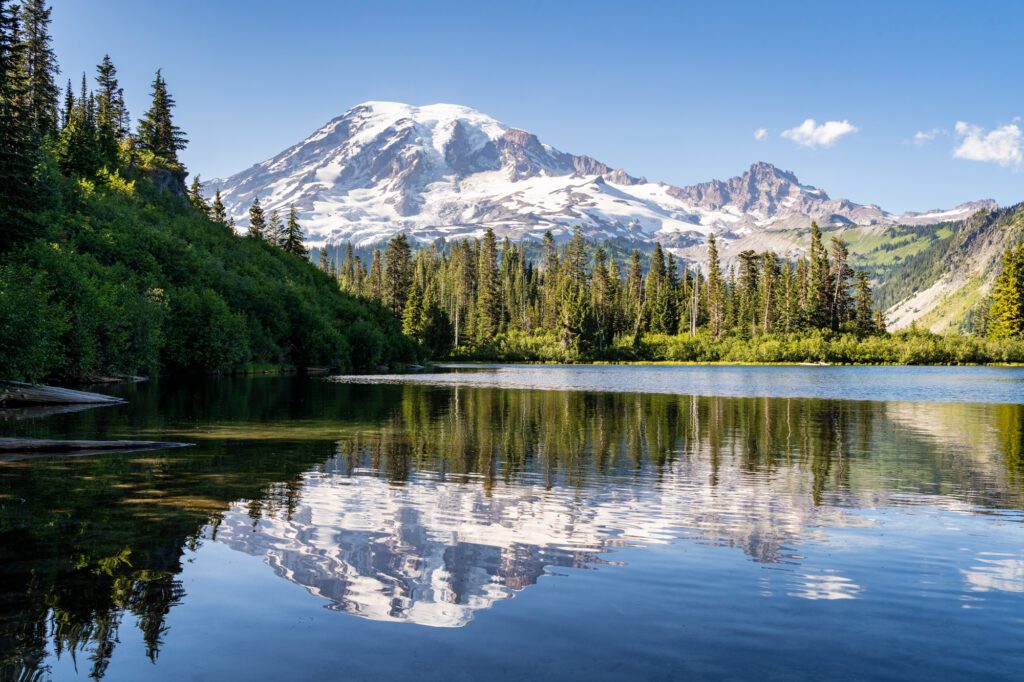
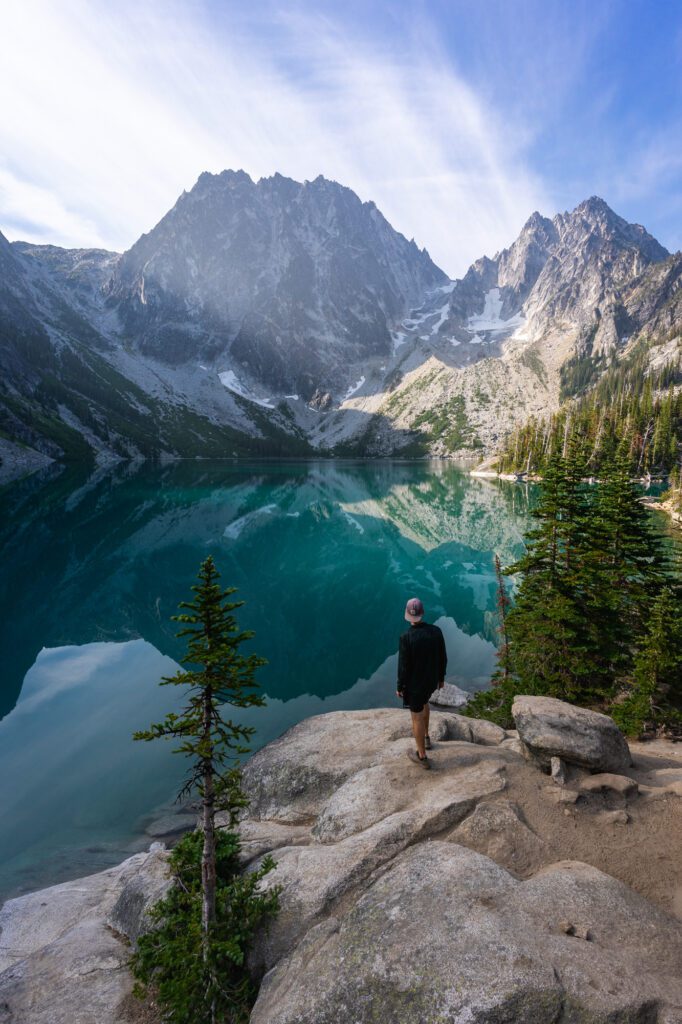

Disclaimer: Some of the links in this post, like hotel links, are affiliate links, meaning at no additional cost to you, we make a little bit of money if you click through and book. That being said, we would never recommend something to you that we don’t stand behind 100%.
How Many Days Do You Need to Explore the Pacific Northwest?
First of all, there’s something you need to know before we get into this guide. The Pacific Northwest is BIG.
Did you know that Oregon is the 9th largest state by area in the United States? We live here in Oregon, and that fact surprised us when we first came across it.
From the southern border of Oregon up to Vancouver, B.C., it’s a ten hour drive. Which means you’re going to have to make some choices on what to see and skip, which is why we’re here!
For the purposes of this guide, we’re only talking about Oregon, Washington State, and British Columbia, which means we’re excluding Idaho, which is usually included, but doesn’t make sense from a travel time perspective.
To tackle the itinerary as written below, which is our version of the “best” itinerary with limited time, you’re going to need 14 days at a minimum.
Even with two full weeks, you’re going to be hard pressed to fit everything in, and are going to need to save some places for a return trip.
If you have seven days or less, we’d strongly recommend focusing your time on EITHER Oregon or Washington. Lucky for you, we have guides to planning an Oregon road trip and a Washington State road trip to help you plan those trips.
If you have 10 days, we’d focus on the corridor between Seattle and Portland, including Mount Rainier National Park and Olympic National Park in Washington, and the Columbia River Gorge and Oregon Coast in Oregon.
If you’re blessed with more time, we have plenty of ideas on what to add in the “with more time” section below the main itinerary.
Our top recommendation if you have three weeks is to add a week between Seattle and Vancouver, which was a tough thing for us to cut because we love that stretch. You can find that in the “with more time” section below.
Our goal here is to give you the information you need to make the most of your limited time, which means making some hard choices on what to do (and what not to do).
In the road trip itinerary below, we’ve done our best to make choices on what to see and what to skip based on our own experience and knowledge of the Pacific Northwest.
For example, we’ve dedicated two days to the Paradise region at Mount Rainier, and relegated the Sunrise region to the “more time” section because it’s too time-consuming to get between them.
Where to Start and End Your Road Trip?
First, you should know that there are three main airports in the Pacific Northwest – Seattle-Tacoma International Airport (SEA), Portland International Airport (PDX), and Vancouver International Airport (YVR).
Since we’re focusing on Washington State and Oregon in this guide, it makes the most sense to fly into Seattle-Tacoma International Airport and out of Portland International Airport (PDX).
To make the most of your time, for this itinerary we suggest flying into one of those and flying out of the other so that you don’t have to waste time driving back to the airport you flew into.
We’ve chosen to have you fly into Seattle and out of Portland here, but you can easily flip it around and do it the other way if that happens to work better for you.
The other option, which makes sense if you’re including Bend on your trip, would be to fly into Seattle and out of Redmond Municipal Airport (RDM), which services the Bend area.
There are pros and cons to that approach – there will be fewer flight options, they will be more expensive, and they will likely have a connection (in either Portland or Seattle).
If you do choose to do that, you’d just move Portland and Mount Hood up before Bend, which is totally doable. It would go Rainier – Portland – Columbia River Gorge – Mount Hood – Bend.
What is the Best Time to Do This Road Trip?
We normally put this section down below the detailed itinerary, but we’ve had enough people ask us about the weather and conditions in the Pacific Northwest that we realized this needs to be up front.
The best time to do this road trip as written below is between July and October.
The reason is that the unique geography of the Pacific Northwest means that there is a very specific “best time” to do this road trip as written.
Because many of the places we’ve mentioned are in the Cascade Range – the mountains that form the spine of Washington and Oregon – some pieces of this itinerary are essentially inaccessible for large chunks of the year.
Between late October and June (though exact timing depends on the year), the following areas will be largely inaccessible: Mount Rainier National Park, Hurricane Ridge in Olympic National Park, and Mount Hood (plus North Cascades National Park, which are in the “more time” section).
If you’re planning to visit outside of that timeframe, we have some good news. There are plenty of places worth visiting in the Pacific Northwest outside of the summer season.
You’ll still be able to use the itinerary below (plus the “more time” section below it) to put together a pretty incredible road trip, though you’ll have to skip some of the places in the mountains.
The Road Trip Route
The main issue you’re working against here when you’re planning your route is that the Seattle to Portland corridor – which is where the region’s two main airports are located – is a relatively small part of the broader two states we’re talking about.
That, combined with the fact that both states are bigger than you think, means that there are going to be some long drives in your future no matter which way you slice it.
For example, Portland to Crater Lake is somewhere around a five hour drive, depending on traffic and conditions.
Here is how we’d spend your time. There will be some long days of driving, but that’s going to be the reality if you want to make it to some of these places.
- Day 1: Arrive in Seattle
- Day 2: Seattle
- Day 3: Olympic National Park (Lake Crescent + Hurricane Ridge)
- Day 4: Olympic National Park (Pacific Coast + Hoh Rainforest)
- Day 5: Mount Rainier National Park (Paradise)
- Day 6: Mount Rainier National Park (Paradise)
- Day 7: The Columbia River Gorge + Hood River
- Day 8: The Columbia River Gorge + Hood River
- Day 9: Bend
- Day 10: Bend
- Day 11: Mount Hood
- Day 12: Mount Hood
- Day 13: Portland
- Day 14: Portland + Fly Home
Here’s what that meandering route looks like on a map so you can visualize what we’re talking about.
Of course, that’s just the base itinerary that we’d recommend. The exact route you take is going to depend on your particular interests, what time of year you’re visiting, and more factors than we can possibly take into account here.
We have ideas for shorter and longer itineraries below the main itinerary if you have more or less time.
One note on the balance of cities vs. nature. We’ve intentionally slanted this itinerary towards nature because that’s what we think makes the Pacific Northwest special. However, you could just as easily cut one or two nature destinations to give yourself extra time in Portland and Seattle, which are both well worth at least 2-3 days, given unlimited time. It depends on what you’re into!
How to Plan an Amazing 14 Day Pacific Northwest Road Trip Itinerary
Now that we’ve covered the important logistics, let’s get into the detailed itinerary!
We’ll do our best to give you all the information you need to plan YOUR road trip through the Pacific Northwest, but if we miss something or you have more questions, leave us a comment below and we’ll do our best to either answer your question, or point you to someone who can.
Days 1-2: Seattle

Any way you slice it, your trip is most likely going to start in Seattle, even if it’s just to snag your rental car and immediately head out to the wilderness.
Now, we recognize that you’re likely coming to the Pacific Northwest to experience its natural beauty. Which is why you’ll find that this itinerary is slanted heavily towards the outdoors.
However, allow us to make a suggestion for your trip. We highly recommend bookending your trip with 1-2 days in Seattle and Portland – which are beautiful cities full of greenery, mountain views, and great food and drinks.
Seattle is set right on Elliott Bay, with views of the snow capped peak of Mount Rainier (which you’ll get to see up close later in the road trip!) from various vantage points.
I, Matt, grew up in the Seattle area, went to college in Seattle, and lived there for a few years before taking a brief detour to California with plans to return to the Pacific Northwest.
I still spend a fair amount of time in Seattle – my entire family lives there – and am consistently flabbergasted by how different the city looks today than, say, 20 years ago. The development and amount of wealth that has flowed into Seattle with the rise of the tech industry is astounding, and the city is experiencing the associated growing pains (like traffic and a housing crisis).
I know I’m biased, but Seattle is a beautiful city with a diverse food scene and great cultural attractions that is well worth a couple of days of your limited time.
What to Do in Seattle
You’re going to have somewhere between one and two days in the city, and we’d roughly split your time in half, spending half of your time in the downtown core where the main tourist attractions are (Pike Place Market and the Seattle Center), and half of your time exploring Seattle’s neighborhoods (like Capitol Hill and Ballard), which are where we think the city really shines.
Here are some of our favorite things to do in Seattle, in no particular order.
Experience Pike Place Market: There are certain tourist attractions around the world – like the Colosseum in Rome or the Louvre in Paris – that are very, very popular, and we’d say that it’s worth braving the crowds for the experience. That’s how we feel about Pike Place Market. Is it “touristy?” Certainly, yes. Is it a key element of any Seattle itinerary? Also yes. It’s worth coming relatively early to beat some of the crowds. We’d skip the gum wall, which is downright disgusting if you really stop to think about it, and instead spend your time on the food and drink vendors in and around the market. Walk through the market and check out the vendors selling everything from candied nuts to flowers, and of course, the flying salmon. Stop by Rachel’s Ginger Beer, Beecher’s Cheese (their flagship cheese is one of my top three all time favorites), and Ellenos Frozen Greek Yogurt while you’re there. To go a level deeper, take this awesome guided tour of Pike Place with a Local Chef.
Seek out the Best View in Seattle: No, it’s not the Space Needle. In fact, we don’t think you should go to the top of the Space Needle. It’s a nice view, sure, but it’s ridiculously expensive AND it’s missing the most distinctive element of the Seattle skyline…the Space Needle. Instead, head just up the hill to Kerry Park, a free public park with a show stopping view of Seattle’s skyline, including the Space Needle, Mount Rainier, and Elliott Bay. You can find it here on Google Maps.
The Museum of Pop Culture: Formerly the Experience Music Project (EMP), this is where Matt had his senior prom wayyyyy back when. It’s a cool space, and the focus is still mostly on Seattle’s influence in the global music scene with bands like Nirvana and Pearl Jam, along with some Jimi Hendrix thrown in. There are als sections of the museum focused on other mediums, like movie production and sci-fi and fantasy. It’s a little pricey, but it’s our favorite attraction at the Seattle Center.
Learn About Seattle’s History in a Unique Setting: A little quirky and offbeat, kind of like Seattle, the Underground Tour is worth doing while you’re in Pioneer Square. The tour guides are funny, and you get to learn about the history of Seattle from a slightly different perspective.
Wander Capitol Hill: Capitol Hill is the most convenient of Seattle’s cool neighborhoods, sitting just across the freeway from downtown Seattle. It’s packed full of interesting spots to stop in, whether you’re looking for vegan ice cream or a unique boutique selling who knows what. Pound-for-pound, it’s probably the best place to eat and drink in the city.
Explore Ballard: Ballard is a little less convenient than Capitol Hill, but we think it’s worth the journey and it’s the neighborhood where we find ourselves drawn to most often when we’re in Seattle. The highlight, by far, is the Ballard Farmers Market on Sunday mornings – if you’re in town on Sunday, absolutely do not miss it. We love Root Plants for coffee, Miro Tea for tea (it’s Alysha’s favorite spot in Seattle), and 8oz Burger for food, among a myriad of other fun spots. Ballard Ave NW is where most of the action is.
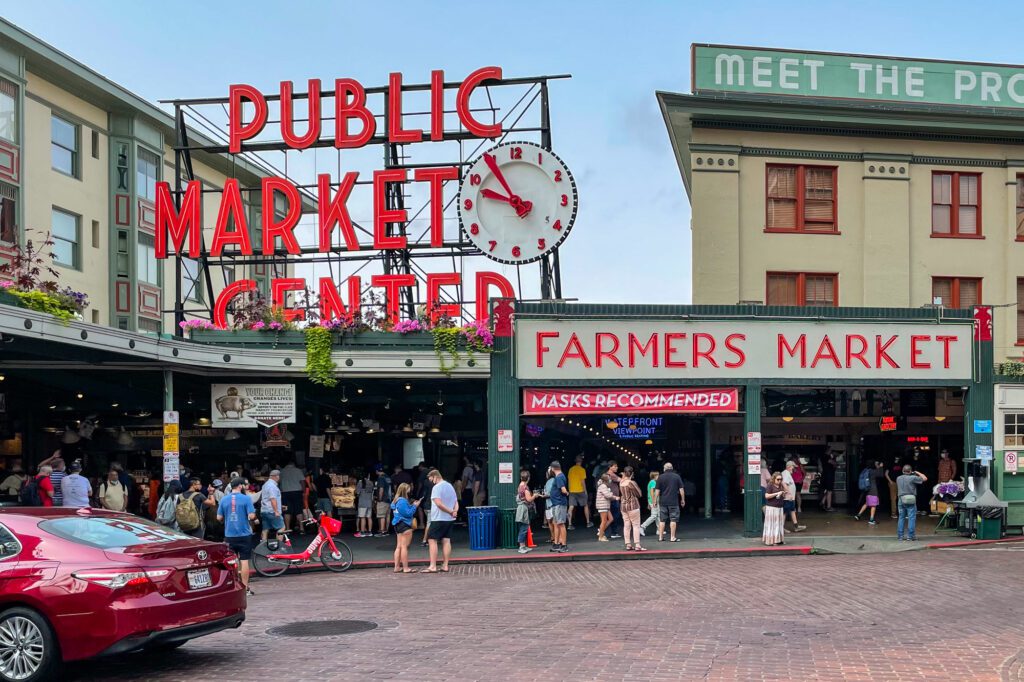
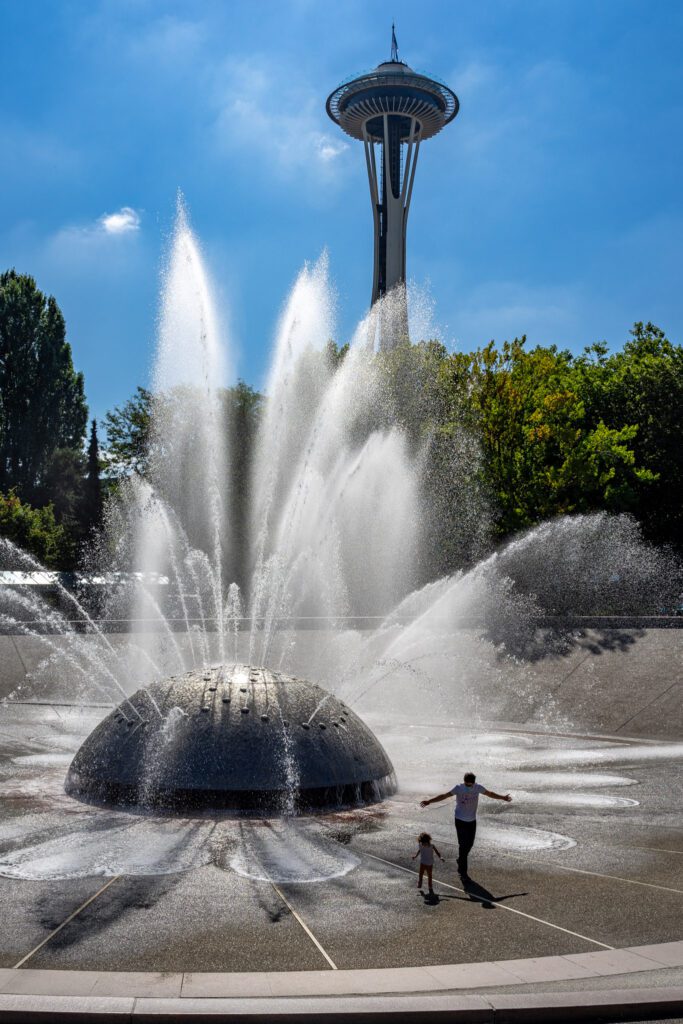
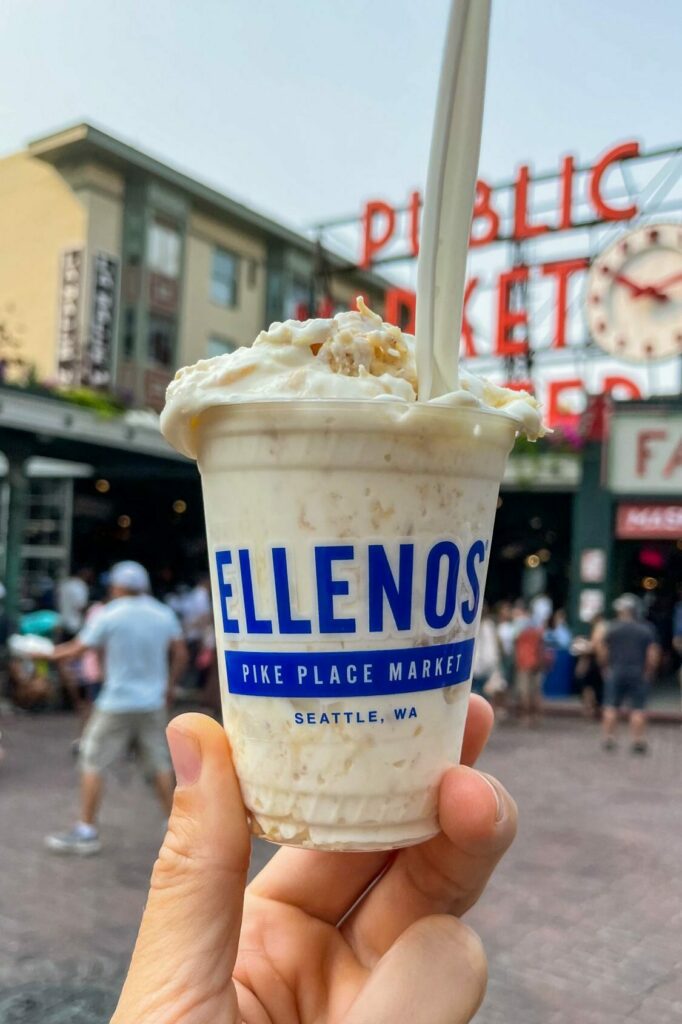

Where to Stay in Seattle
If you’re only in town for a couple of nights, we’d make sure to stay centrally, which means staying somewhere in the downtown core of Downtown Seattle, Belltown, or South Lake Union.
Keep in mind that if you’re renting a car, street parking is nonexistent.
You’ll need to either park at your hotel and pay a premium, park at a parking garage in downtown Seattle near your hotel (ask the hotel if they have any recommendations – do not leave ANYTHING in the vehicle), or wait to rent a car until you’re on your way to your next stop.
Given limited time, it probably makes the most sense to pony up for parking for a couple of days to streamline things.
We have stayed at – and recommend – the CitizenM in South Lake Union.
It’s within walking distance (~15 minutes to Pike Place Market or Seattle Center) to most of the sights you’re going to want to see, the rooms are modern and comfortable, and the staff are super friendly. We’ve stayed in three different CitizenM hotels in the past year, and love them.
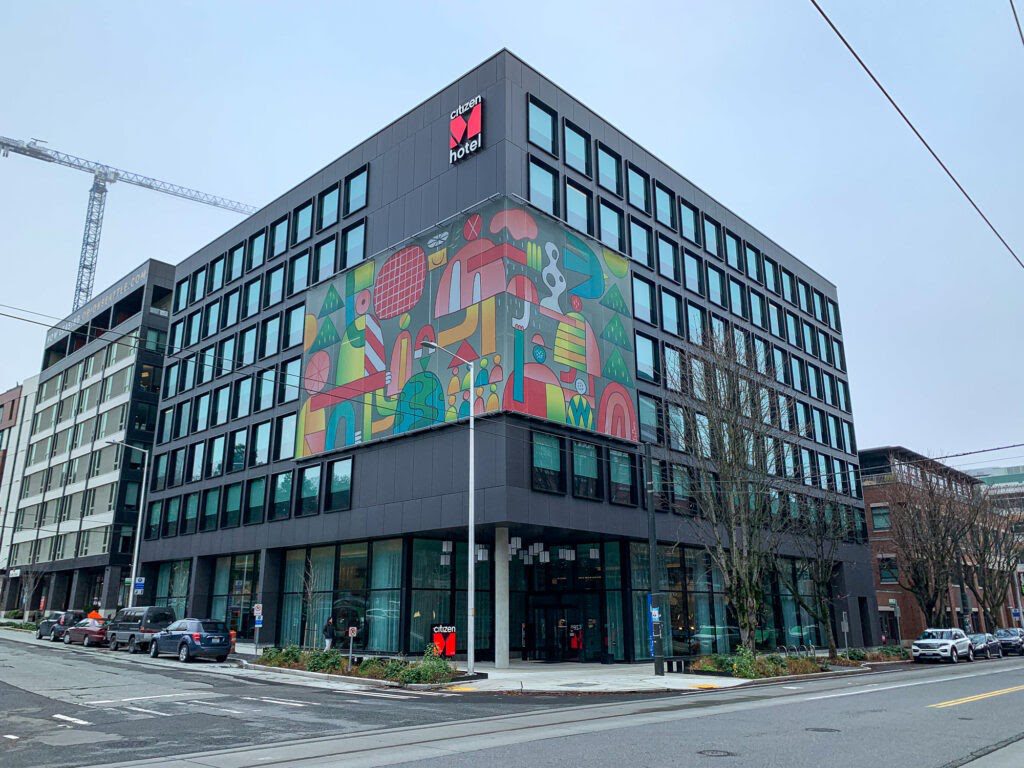
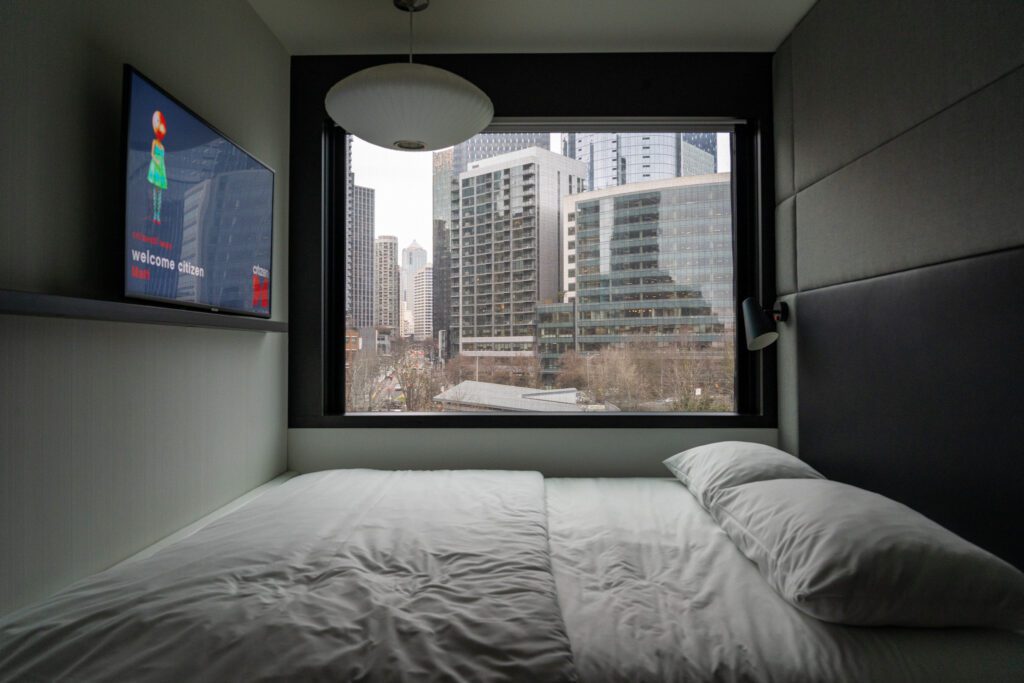
If you’re interested, you can read more about our stay at the CitizenM South Lake Union.
Some other hotels we’d recommend are the Ace Hotel Seattle (the original Ace Hotel – we stayed there a few years back and it’s a great location), the State Hotel (a boutique hotel around the corner from Pike Place Market), and Hôtel Ändra (a Scandinavian-inspired boutique hotel in Belltown).
Days 3-4: Olympic National Park

Drive Time & Distance: 2 hours and 23 minutes // 82 miles
Situated at the northwestern corner of the contiguous United States, Olympic National Park is the most diverse of the three national parks in Washington State in terms of landscapes.
Within the park, which sprawls out over the Olympic Peninsula, you have several distinct ecosystems, including alpine sections, rocky beaches, and the world-famous coastal temperate rainforests that thrive in the mild, wet weather in this part of the world.
One note here: We’d strongly recommend you take the Bainbridge Island Ferry – which is a car ferry – across the Puget Sound from Seattle. It’s faster than driving around, and more importantly, it’s 1,000 times more scenic (though it does cost more). On a nice summer day, you can see Rainier, Baker, and the Olympic Range from the deck of the ferry.
Here’s a view from that ferry ride to convince you.
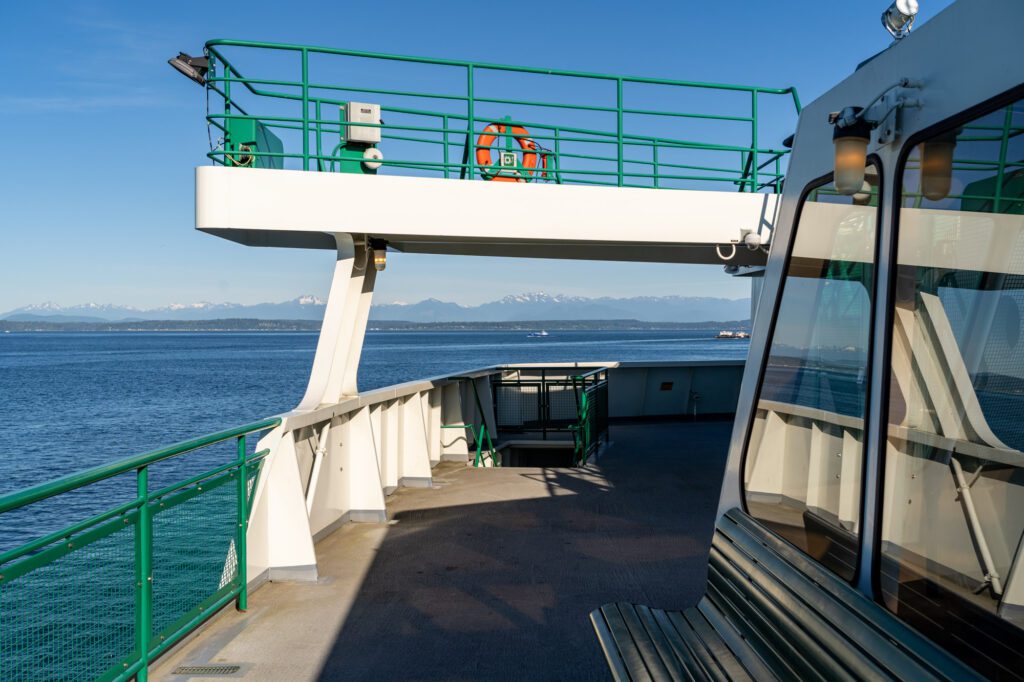
Before we get into what to do in Olympic National Park, we need to take a second to talk about the park’s geography.
There are four main regions of the park that we’d recommend that you take the time to explore.
- Hurricane Ridge & Lake Crescent – This region features towering mountains on the north side of the Olympic Peninsula. It’s easy to get to from all points east, like Seattle, and it also sits just 17 miles south of Port Angeles. Don’t miss Sol Duc Falls, Marymere Falls, and Hurricane Hill.
- La Push Beaches – Rialto, First, Second, and Third Beach will all provide you with million-dollar sunsets and views onto the sea stacks with cliffs rising up from the sea. Make sure to look up too! You might spot the elusive bald eagle waiting patiently for its next meal (we saw two on our recent trip).
- Hoh Rainforest – This is the moss-covered rainforest region that features sphagnum moss, wildlife, old-growth Sitka spruce, ferns, banana slugs, and wildlife of all kinds.
- Lake Quinault – This is a region in the western part of the park that features the stunning Lake Quinault, located within the extraordinary Quinault Rainforest.
Normally, we recommend at least three days for an Olympic National Park itinerary. However, we’re working with limited time here, so we’re cutting that to two and focusing on the highlights.
Given limited time, we think you should focus your time on Hurricane Ridge, the Pacific Coast, and the Hoh Rainforest, which is more than enough to fill a couple of days in the park.
To make the most of your time here, you’ll want to make a counter-clockwise loop starting with Hurricane Ridge and Lake Crescent, moving west to Forks and the Pacific Coast, and ending with a drive south along the coast, with a few beach stops along the way.
This will also set you up nicely for your drive to Mount Rainier National Park, your next stop.
It also makes sense to split your time in terms of where you stay, staying one night in the northern region of the park, and one night out on the coast near Forks.
You’ll want to spend your first night near Port Angeles, a good home base for Hurricane Ridge and Lake Crescent, then spend the next night in Forks (yep, that Forks) to do the Hoh Rainforest and Pacific Beaches.
One other thing: There are no two ways about it – getting from the Olympic Peninsula to Mount Rainier National Park requires some driving, so be prepared for a long drive at the end of this leg.
What to Do in Olympic National Park
Here are some of our favorite things to do in Olympic National Park. We’ve ordered them in the order you’ll encounter them on your counter-clockwise loop around the tip of the Olympic Peninsula (from Port Angeles, to Forks, to Lake Quinault).
Hurricane Ridge: Your first stop is Hurricane Ridge, which is at the northeastern corner of the park. To get up to the ridge – the highest point in the park that you can drive to – you’ll climb a steep, windy road (that closes in the winters for somewhat obvious reasons). Once you’re there, hike Hurricane Hill for excellent sweeping views of Western Washington. Then, drive out to Obstruction Point for more great views of the Olympic Range. If you want a longer hike, the hike to Grand Lake leaves from the end of Obstruction Point Road.
Lake Crescent: Lake Crescent is the second deepest lake in the state, and you’ll find it about 20 miles west of Port Angeles along Highway 101. There are a couple of things to do and see here. First is the Lake Crescent Lodge, which is a historic lodge right on the lake (as you might imagine) that would be a great place to grab a drink and a snack after a morning of exploring (bonus points if you sit in the adirondack chairs on the lakeshore). Second are the hikes to Marymere Falls (short and easy stroll through the forest to a waterfall) and Mount Storm King (tough hike straight up to a nice view over the lake).
Sol Duc Falls: Our favorite waterfall in the park, this is a little bit of a detour from Lake Crescent. We encountered it on our hike on the High Divide, a great backpacking trail that leaves from the same trailhead. It’s a very short, mostly flat stroll through the woods to a wooden bridge over the falls.
Rialto Beach and Hole-in-the-Wall: If you made us choose, this hike is in our top three when it comes to hikes in Olympic National Park. It’s a flat stroll along the beach (hiking in the sand does suck, so be prepared for that) out past towering sea stacks, tidepools, and bald eagles sitting in the trees to a rock formation with a hole in it. We got super lucky on our first ever trip with perfect weather at sunset, which is the best time to do this hike, but your experience may vary (we’ve since been here twice in the summer, and it has been gray and raining both times).
The Hoh Rainforest: The most famous of the coastal temperate rainforests in the Pacific Northwest, the Hoh Rainforest is lush, ferny, and mossy. It’s also busy, so we’d recommend trying to structure your itinerary here to make sure you’re parked and on the trail by 9am at the latest to avoid the long lines that form at the entrance station. Once you’re parked, do the short Hall of Mosses and Spruce Nature Trail, and if you’re up for a relatively easy walk, do the first portion of the Hoh River Trail, which sees a fraction of the people that those first few trails see and is a very pleasant walk.
Ruby Beach: Ruby Beach is one of our favorite beaches on this stretch of coast, and it’s a short walk away from the parking lot, and makes a nice stop between the Hoh Rainforest and Kalaloch (which is the last beach in the park before you head to Rainier). It’s everything you want in a coastal beach in Washington State – driftwood, sea stacks, and abundant bird life.
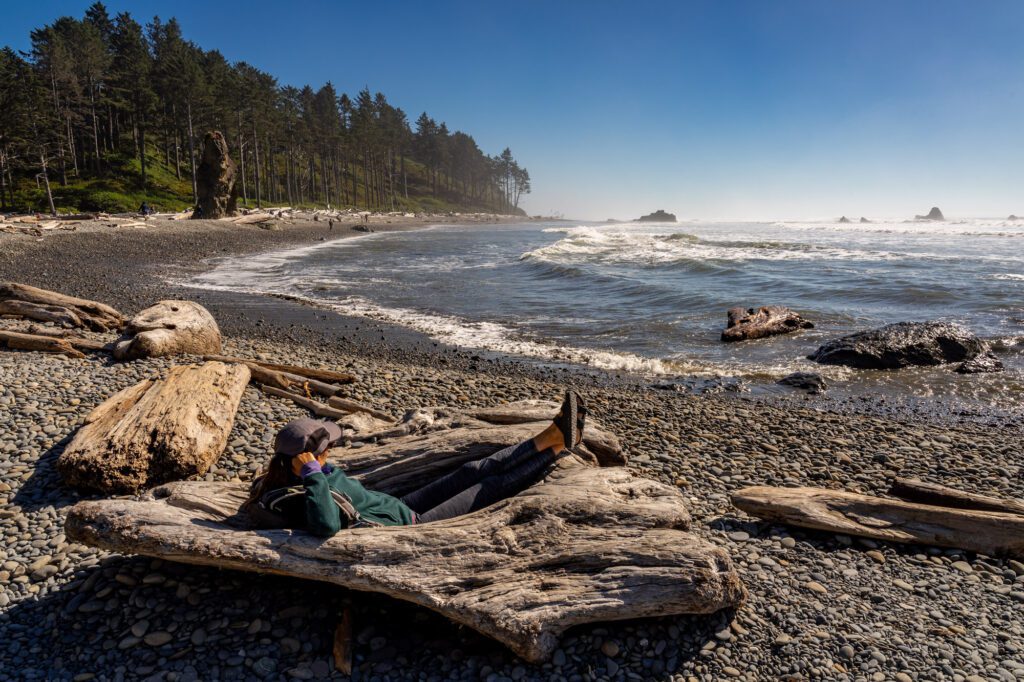



Where to Stay in Olympic National Park
Given the context of this trip, where you’re coming from Seattle and your next stop is Mount Rainier, we’d recommend spending your first night in Port Angeles at the northern end of the park, and your second night in Forks (again, yes, that Forks) near the Pacific Coast and rainforest.
That’ll make a nice counterclockwise loop around the Olympic Peninsula, leaving you in a good position to make your way east to Mount Rainier.
By the way, we have a whole, much more detailed guide to where to stay in Olympic National Park, which has our picks for the best places to stay in each region (Port Angeles and Forks, mainly) along with what you need to know about camping.
Days 5-6: Mount Rainier National Park (Paradise)
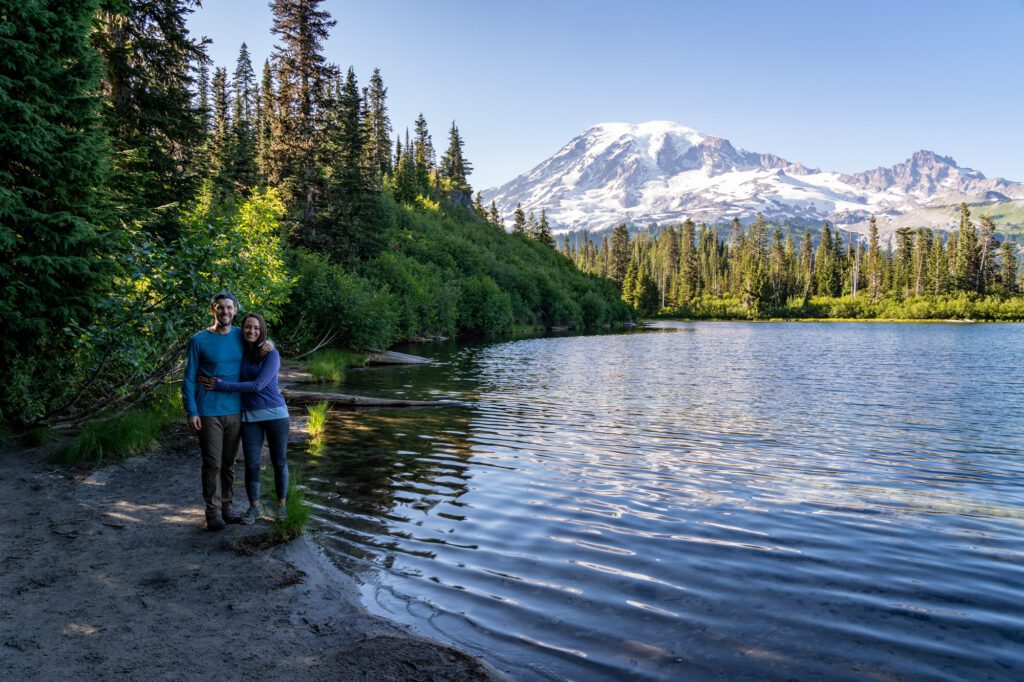
Drive Time & Distance: 5 hours // 248 miles
If you didn’t already know, we spent almost two years living in a converted Honda Odyssey on a never ending road trip around the western United States starting in 2020. During that time, we hit every national park in the west, except for the Channel Islands.
Mount Rainier National Park is in our top three, and we revisit it every chance we get (which usually means a few days once or twice every summer and fall).
Before we get to what to do and see at Mount Rainier, let’s quickly cover the geography of the area.
There are three main areas of Mt. Rainier National Park: Paradise, Sunrise, and Mowich Lake.
Here’s a quick summary of each.
- Paradise – Best for first-time visitors: Paradise is the most popular area to visit, located on the southern side of the Mountain, and home to some of the best wildflower meadows and lakes in the park.
- Sunrise – Best for epic hikes: Sunrise, which is on the east side of the park, is the highest point in Mount Rainier National Park that you can drive to. Several of our favorite hikes in Mount Rainier National Park leave from the big parking lot at the visitor center.
- Mowich Lake – Best for peace and quiet: Mowich Lake, on the northwestern side of the mountain, is the quietest area of the park. It is free from the tourist hype of Paradise and Sunrise, and the long and arduous bumpy gravel road to get there cuts the number of visitors significantly.
The problem with Mount Rainier is that it takes a LONG time to get between those different areas. Paradise and Sunrise are roughly 90 minutes apart (one way), which makes it a long journey for a day trip with limited time.
If it’s your first time and you only have a couple of days, we’d recommend basing yourself for your two days in the Paradise area.
Paradise is our favorite part of the park with the best diversity of scenery (wildflower meadows, alpine lakes, and waterfalls) with plenty to do and see to fill a couple of days.
It also happens to be the most convenient place to access your next stop on this road trip, which will take you south down to Oregon.
What to Do in Mount Rainier National Park
Here are our favorite things to do in Paradise.
Hike the Skyline Trail: The Skyline Trail is one of the best hikes in Washington State. From the lush subalpine wildflower meadows, to the rocky alpine terrain and up-close-and-personal view of Rainier’s face, to the sweeping views out over the Tatoosh Range and Mount Adams, it’s spectacular from start to finish. And we didn’t even mention the marmots and mountain goats yet! It’s a difficult hike, and you need to be prepared for a fair amount of climbing and lots of sun exposure. We have an entire guide dedicated to hiking the Skyline Trail – including logistics like which direction to hike and a complete trail guide – which you should read for more detail.
Go chasing waterfalls: One of our favorite parts about Paradise is the great waterfalls. There are four main falls, and one of them – Myrtle Falls – is on the Skyline Trail. There are two that are accessible with a short walk from the parking lot – Christine Falls, framed by a picturesque stone bridge – and Narada Falls, which are on the road up to Paradise. The last is Comet Falls, which is the most impressive of the bunch and requires a quick hike to reach (you can read about it in our Comet Falls trail guide).
Capture a perfect reflection at Reflection Lakes: Reflection Lakes is one of our favorite views in the park, especially at sunrise or sunset. On a clear day, there’s a near-perfect reflection of Rainier’s glaciated peak in the water. BEWARE: the bugs here in the summer are intense. Matt is a magnet for mosquitoes and flies, and he braved the swarms of them to get some photos at sunrise and sunset on our last few trips.
Tackle some other hikes near Paradise: While the Skyline Trail is our favorite of the bunch, there are several other hikes that are worth your time here. The first we’d recommend is Bench and Snow Lakes, which we overlooked ourselves until our last foray into the park, and want to help you avoid making the same mistake. It’s a great pair of lakes, and the hike in is tough enough to discourage most of the crowds, but easy enough for most people to make it out to both lakes. Second is Comet Falls, which is the most impressive waterfall in the park. Third is Pinnacle Peak, a tough climb up to a saddle with great views of Rainier.

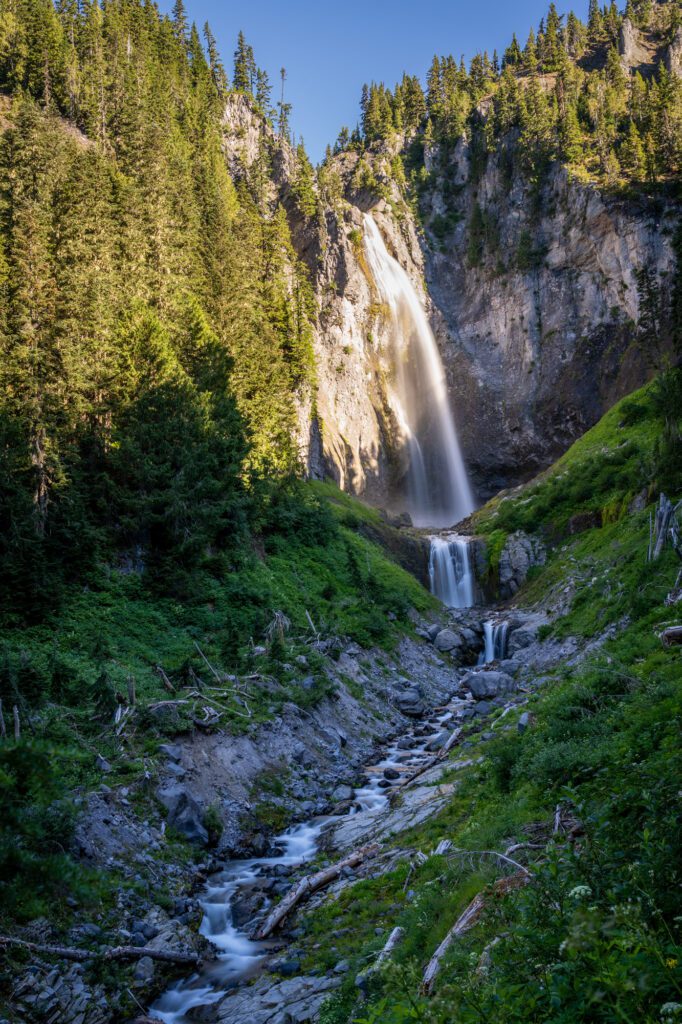
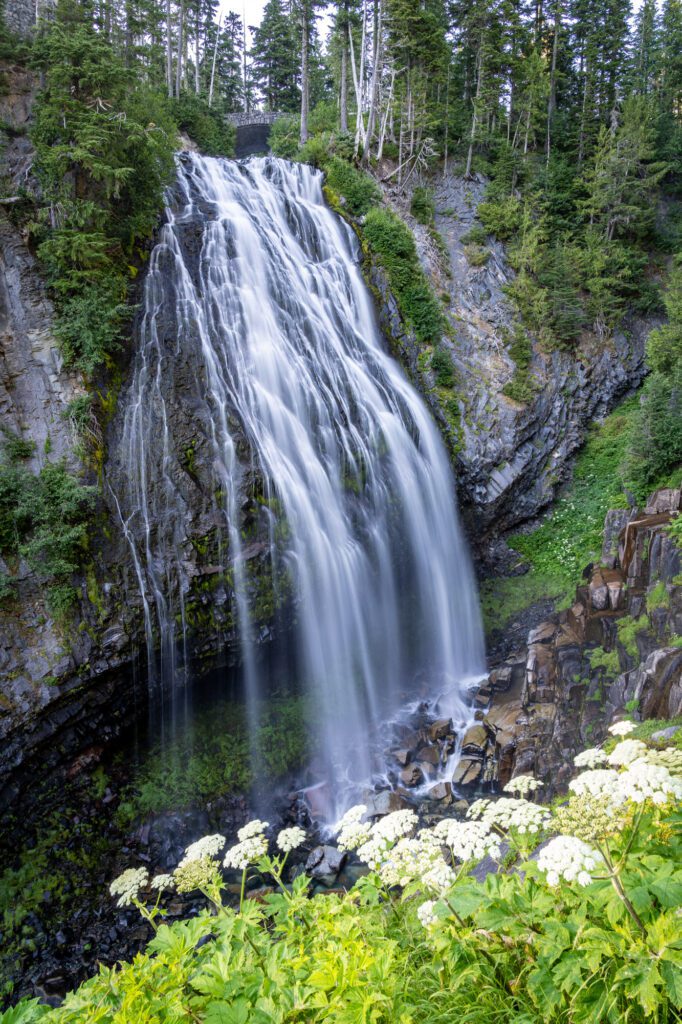
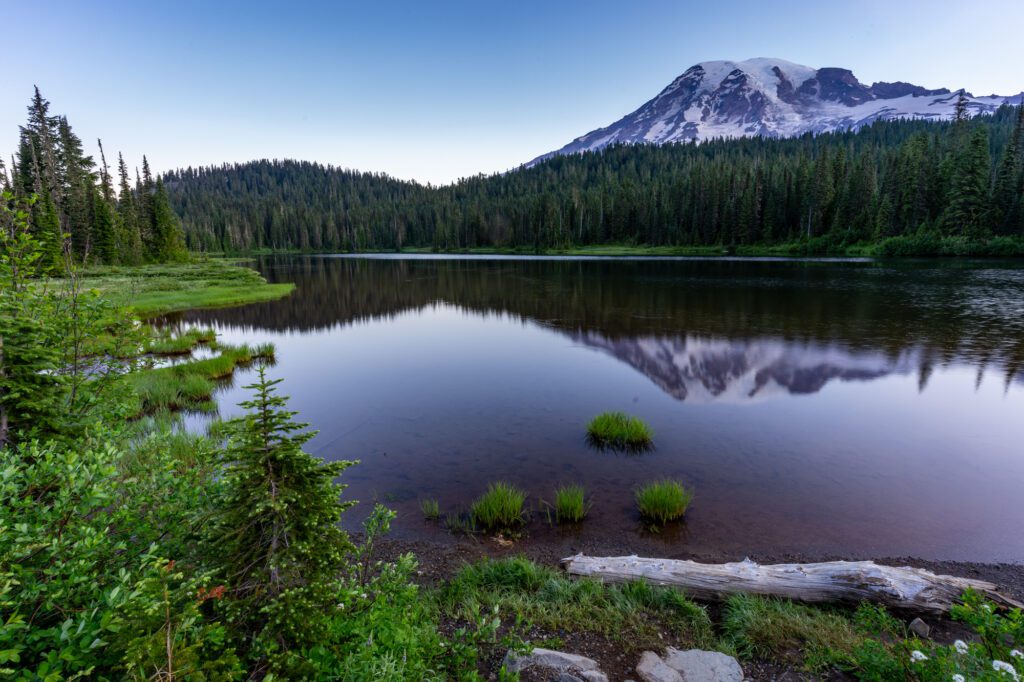
Where to Stay near Paradise at Mount Rainier National Park
You’re going to want to base yourself near Paradise, which is on the south side of Rainier near the Nisqually entrance and the town of Ashford.
If you’re camping, Cougar Rock Campground is a great home base for exploring this part of the park. It’s where we camp when we visit, though it’s tough to get reservations for summer weekends. More information here, including how to reserve a site.
If you’re not camping, the town of Ashford is the best option.
Sitting just outside the Nisqually Entrance, Ashford has a couple of nice hotels and a range of cabins in the woods if you’re looking for more space and a little more privacy. It’s the best location both in terms of accessing Paradise, and getting out to the I-5 corridor for your next stop.
For more detail, make sure to read our guide to the best places to stay at Mount Rainier.
Days 7-8: The Columbia River Gorge and Hood River
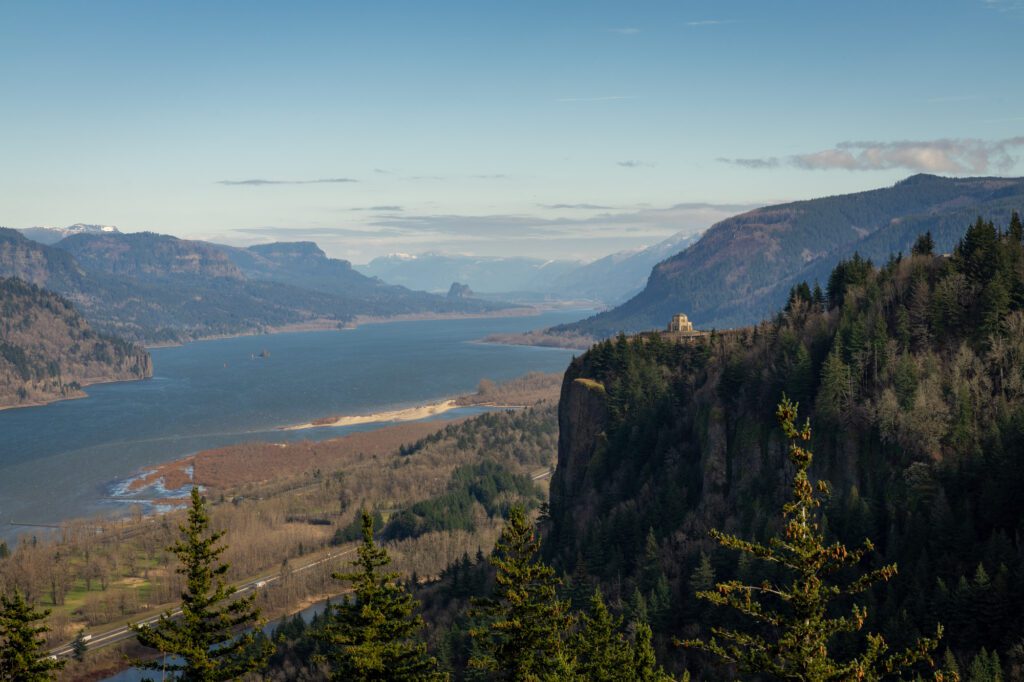
Drive Time & Distance: 4 hours // 210 miles
After Rainier, you’ll be making your way south and crossing the Oregon border – which is the Columbia River (the one that Lewis and Clark traveled up to “discover” Oregon) – bringing you right into our own backyard.
The Columbia River Gorge is nearly as impressive as the two national parks you’ve already seen, but in a different way. Millions of years of water running down the Gorge, combined with ample volcanic activity, have formed this massive chasm that separates the two main states in the Pacific Northwest.
The Oregon side of the Columbia River Gorge, which is shaded by the walls of the Gorge, is lush, wet, green, and full of a stunning array of impressive waterfalls.
The Washington side of the Gorge, which gets more sun exposure with its south facing hillsides that makes it drier and a paradise for wildflower hunters in the spring, features some of the best views of the Gorge from various hikes along the river.
Hood River sits at a unique point in the Gorge, and is a good home base for your explorations over the course of a couple of days. We say unique because of its geography. Head in any direction and the geology and topography changes drastically.
East of Hood River deeper into the Gorge, you start to get into the High Desert. South of Hood River, you pass through the fertile Hood River Valley before climbing up into the Cascade Range. And west of Hood River is the lush Oregon side of the Gorge.
The Gorge and Hood River is our favorite day trip from Portland, and we take almost every visitor that comes to see us in Portland out to experience the natural beauty that exists roughly 30 minutes from our front door.
What to Do in the Columbia River Gorge & Hood River
Like we mentioned, we spend a lot of time exploring the Gorge and Hood River because they’re so accessible from our home in Portland. Here are some of our favorite things to do.
Waterfalls in the Gorge: The best concentration of waterfalls exists on the Oregon side of the Gorge. Try to get to Multnomah Falls (here on Google Maps), which you’ve undoubtedly heard of and seen pictures of, early in the morning to beat the crowds and tour buses that make it a zoo starting at around 10am. We really like Horsetail and Ponytail Falls (here on Google Maps) and the short hike to Wahclella Falls (here on Google Maps) which are a great bang-for-your-buck in terms of beauty to effort ratio.
The Best Views of the Gorge: For some of the best views of the Gorge, there are a couple of viewpoints on the Historic Columbia River Highway that are worth a stop – the Vista House (here on Google Maps) and the Women’s Forum Viewpoint (here on Google Maps). In terms of hikes with a nice view, we love Angel’s Rest, which is a moderate climb to a rocky outcropping with great views up and down the Gorge. There are also some great views from the Washington side from Beacon Rock, the Hamilton Mountain Trail, and the Dog Mountain Trail.
The Fruit Loop: The Hood River Fruit Loop refers to a particularly fertile section of the Hood River Valley that features fruit trees as far as the eye can see and excellent views of Mount Hood and Mount Adams, depending on which direction you’re looking. We love stopping at the fruit stand at Draper Girls (they also do u-pick fruit in the summer) and the Gorge White House for a drink in a nice location. For a great view of the valley and Mount Hood from above, head to Panorama Point (here on Google Maps).
Tamanawas Falls: This is a beautiful hike, and is equally as impressive as some of the waterfalls in the Gorge for a very reasonable effort. It’s about 30 minutes south of Hood River, and the trailhead is right off of Highway 35 on the way towards Mount Hood.
Wine Tasting near Hood River: Hood River is a good place to go wine tasting because it’s more low key than the Willamette Valley – one of the premier wine regions on the west coast – but still has a baseline quality of wine. We prefer the wineries on the Washington side of the Gorge, and Loop de Loop is our favorite of the bunch. Other good ones that have been recommended to us by various locals are Savage Grace and AniChe (which are near Loop de Loop). On the other side of the Gorge, it’s worth driving a bit further east to hit Annalemma Wines.

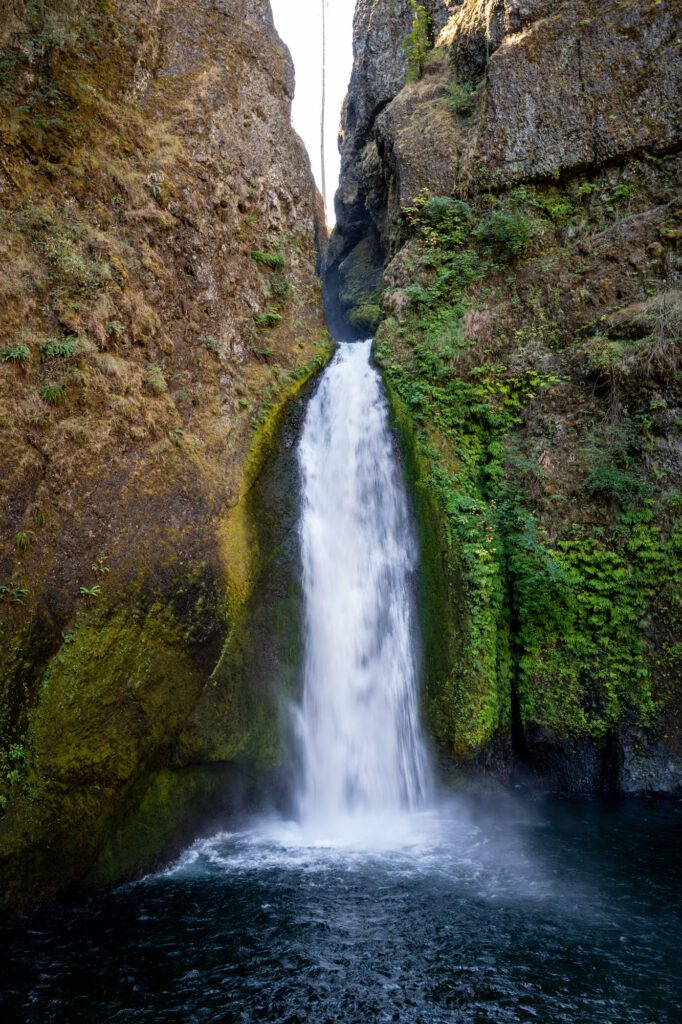
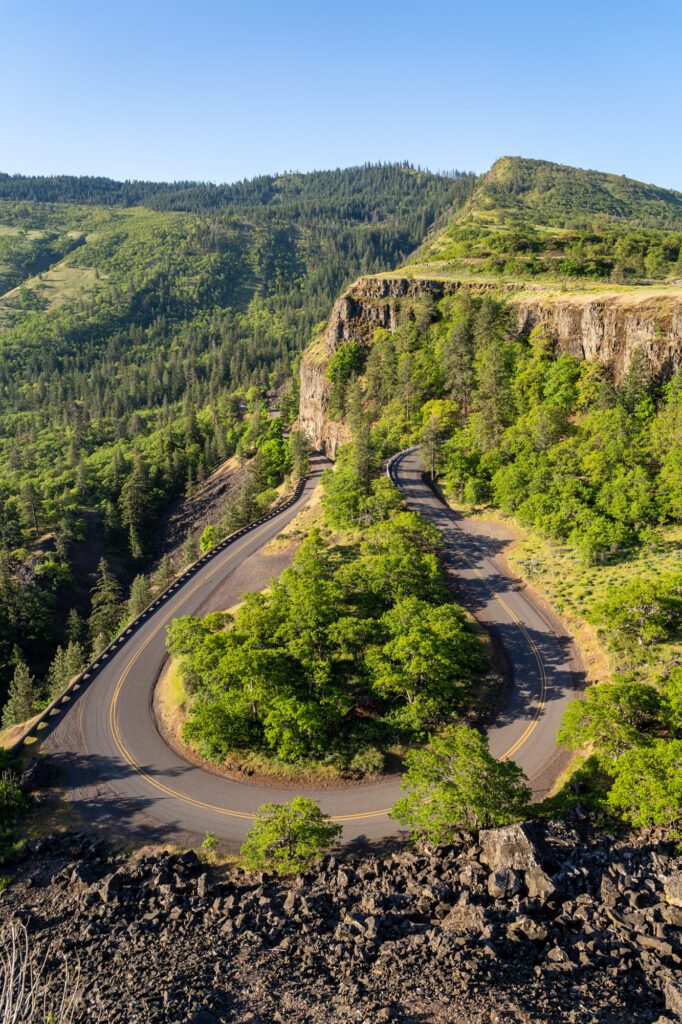
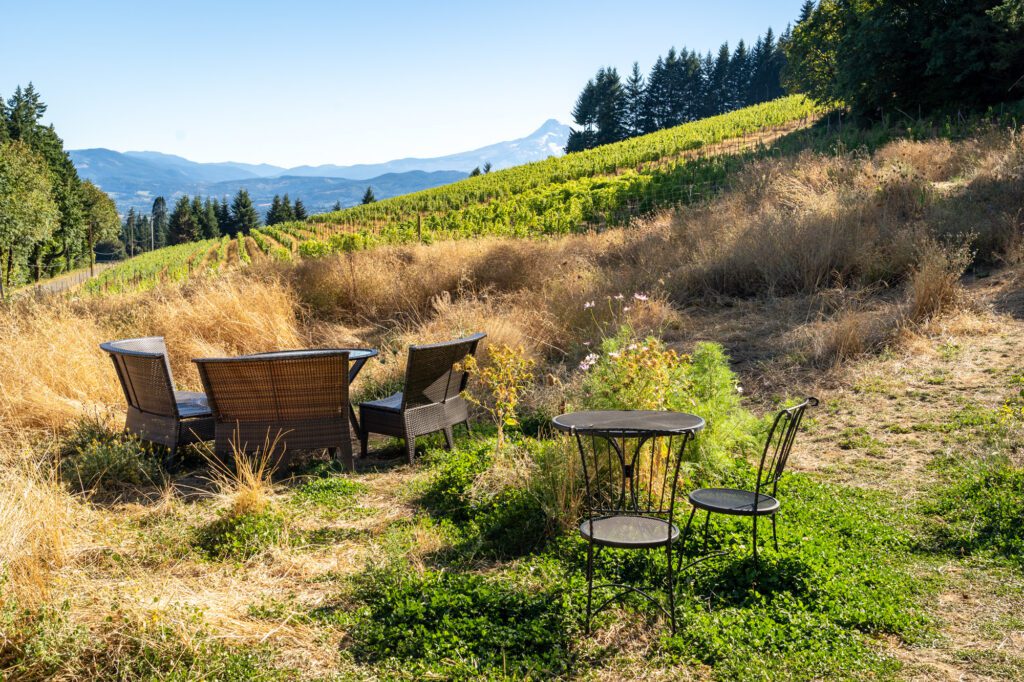
Note that we actually have a completely separate website dedicated to our explorations in Oregon called Oregon Obsessed. Here are our Columbia River Gorge guides from that site.
- 15 Incredible Waterfalls in the Columbia River Gorge
- What to Do in Hood River: A Complete Guide for First Timers
- The 16 Best Hikes in the Columbia River Gorge
- How to Hike the Hamilton Mountain Trail in the Gorge
- Hiking the Gorgeous Wahclella Falls Trail in the Gorge
Where to Stay in the Columbia River Gorge & Hood River
Generally speaking, you basically have two options here. Stay right in town (or close to it), or stay somewhere more secluded and private.
If you want to be walkable to town, we’d look at the Best Western right on the Marina, which has some rooms that have kitchens.
If you want something more secluded and private, we’d look across the river to the charming little town of White Salmon.
We have personally stayed at and loved the RubyJune Inn, which is a B&B in the truest sense (and the breakfast is fantastic, sourced from local bakeries). No kids, no pets allowed, and the two owners are a wealth of knowledge about what to do, see, eat, and drink in the area (especially wine).
Days 9-10: Bend
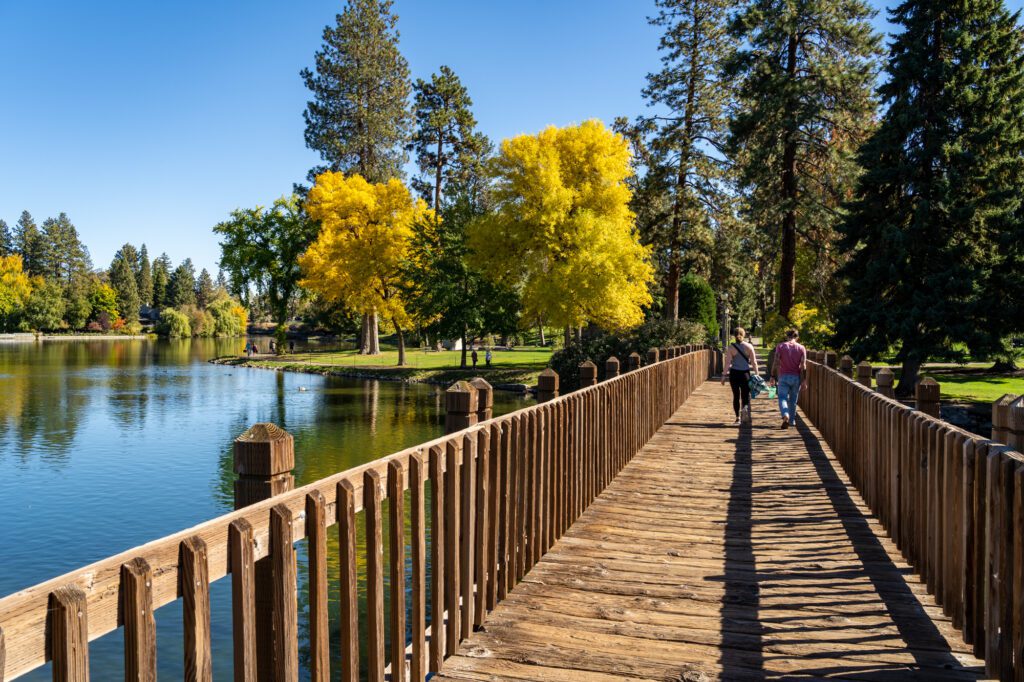
Drive Time & Distance: 2 hours and 50 minutes // 143 miles
Bend, similar to Hood River, is in a unique geographical location. It sits at the turning point between the alpine and subalpine environment in the Cascades and the high desert that’s nestled in Central Oregon between the mountain ranges on either end of the state.
Plus, volcanoes! There’s lots of volcanic activity here that has shaped the landscape.
That diversity has meant that Bend has become a little slice of paradise for adventure lovers over the past several years, and has gained nationwide notoriety with lots of media coverage recently. Though it has always been on the map of most adventure-loving Pacific Northwest residents.
If you’re an astute reader and you’ve been following along on a map (or just looked at the one above), you’ll notice that heading out to Bend actually represents a little bit of a detour because your next stop (Mount Hood) is actually pretty close to Hood River.
In order to get down to Bend, you’ll head south from Hood River, passing through the eastern foothills of Mount Hood to get to Bend. Then, you’ll double back and hit Mount Hood on your way back to Portland.
First of all, that detour is absolutely worth it, and you should definitely make an effort to include Bend as a part of your road trip. Both because of Bend itself, and because of the diversity of landscapes you’ll find just outside of Bend.
Second of all, we have it structured this way (rather than doing Hood then Bend) to maximize your time on the way back to Portland. Going up to Hood and then over to Portland means you avoid the I-5 corridor south of Portland, which is known to be a traffic-filled nightmare on most days of the week.
Anyway, we love Bend and we just spent a full week there exploring recently, which opened our eyes to the diversity of things to do and see within about an hour of the city.
What to Do in Bend
Bend is a big city by Oregon standards – and growing FAST – and there’s plenty to do to fill a full week (or a full month, or year, you get the idea).
With limited time in and around Bend, here is what we’d focus on.
Smith Rock State Park: Smith Rock is one of the destinations that is most emblematic of the stark contrast between the wetter, greener part of the state that we live in (west of the Cascades) and the high desert on the east side of the mountains. It looks like it belongs in Utah, not the lush Pacific Northwest! But the Pacific Northwest is more than evergreen forests. The best trail in the park is the Misery Ridge Trail, which has two route options (after the brutal climb up to aptly-named Misery Ridge) – the shorter, flatter River Trail and the longer, more difficult Summit Trail. It’s between Bend and Mount Hood, so you can stop on the way in or out of Bend (we’d try to go early, because it does get hot and there’s very little shade).
The Deschutes River: The Deschutes runs right through the center of town – and is one of the biggest reasons why Bend is located where it is. Today, it isn’t really the lifeblood of the city, but it is full of recreation opportunities. There’s a long trail that follows the path of the river south from Bend, and we love doing a short portion of it as part of any visit to Bend (here’s the rough route that we usually do when we’re in town). The other thing you should try to do – as long as it’s summertime – is get out on the water! You can float the river from Drake Park down to Riverbend Park. Rent a tube from Tumalo Creek and use the Ride the River service, which shuttles you to the entry and exit from the river.
The Cascade Lakes Scenic Byway: This is one of our favorite places in the entire state. It’s a corridor that runs west out of Bend into the Cascades into a land of pine trees, gorgeous lakes, and great hikes. Definitely stop by a couple of the lakes – Sparks Lake and Elk Lake are our favorites. It’s well worth spending a day exploring this part of the state, and there are a nice range of hikes to choose from. Here are three of our favorite Bend hikes:
- Green Lakes (9.1 miles // 1,174 ft. elevation gain): A nice, relatively easy (but long) creekside stroll through the forest out to a series of lakes backed by the South Sister and Broken Top. Lovely hike!
- Tumalo Mountain (4.1 miles // 1,423 ft. elevation gain): Short and sweet, this hike climbs straight up to the top of Tumalo Mountain where you’ll have sweeping views out over the valley and surrounding peaks. Particularly nice at sunrise or sunset!
- Moraine Lake (5.2 miles // 1,476 ft. elevation gain): This was an unexpected delight last fall! It starts with a climb through the forest, and a couple of miles in you burst forth from the forest out into a basin with great views of both the South Sister and Broken Top before you head down to the lake (which is tucked right at the base of the South Sister).
Newberry National Volcanic Monument: This is the volcano that shaped the high desert in Central Oregon, and it’s almost a mini-Crater Lake in terms of how it was formed and how it looks today. There are two parts of the monument, and they’re about 30 minutes apart. The first you’ll encounter heading south from Bend is the Lava Lands Visitor Center, which is where you’ll find the Trail of the Molten Land (walk through a lava field!) and Lava Butte. Continue South to Paulina Lake and the Newberry Volcano, where you’ll find a large lake, the hike up to Paulina Peak (which features incredible views over the surrounding landscape, including the vast lava fields), and Paulina Falls.
Tumalo Falls: A nice waterfall just outside of town. There’s a longer hike that you can do that follows the creek, or you can drive right up to the lower viewpoint and follow the short trail up to the upper viewpoint (which would be our strong recommendation).
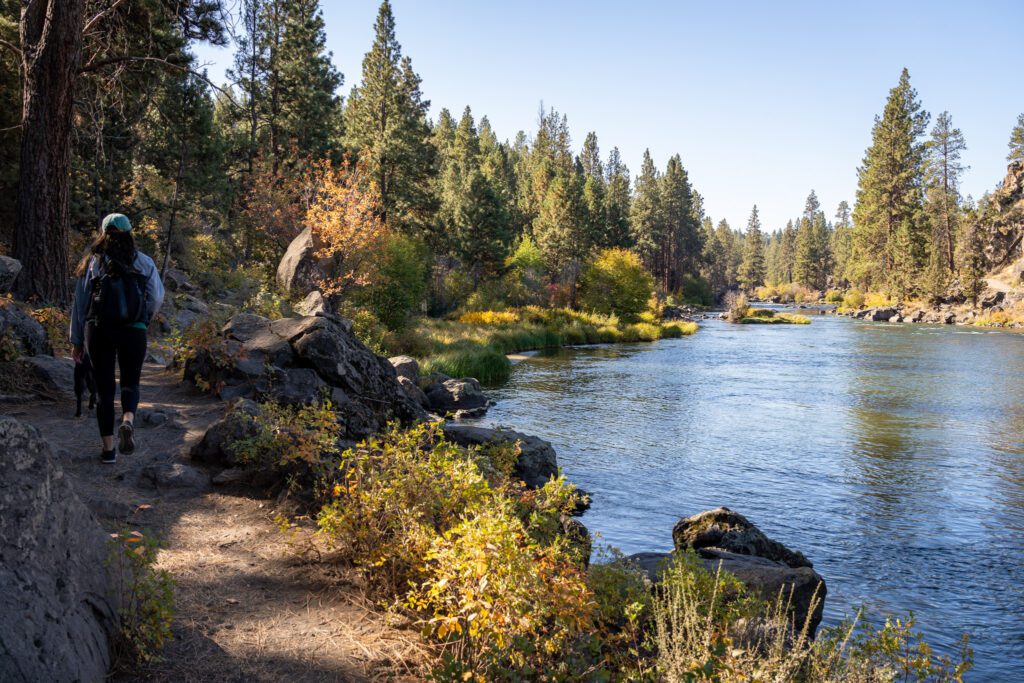
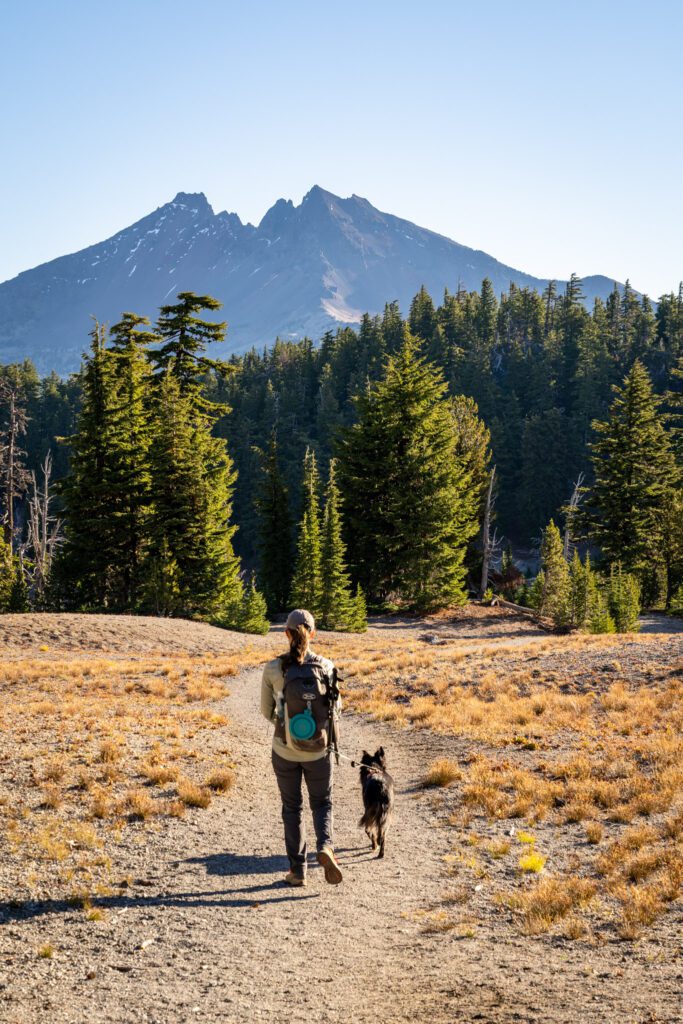
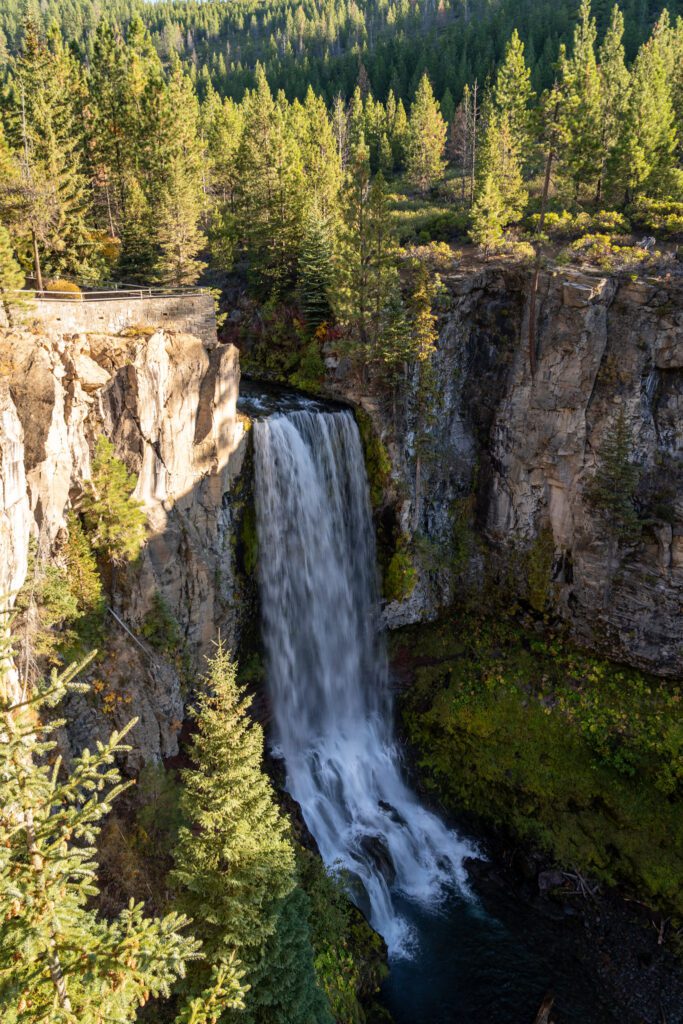

Where to Stay in Bend
With only a couple of days in town, you have two choices when it comes to where to stay. Stay right in town, or stay on the outskirts in a more quiet locale.
For the purposes of this trip, we’d recommend staying in town so you can be within walking distance (or a short drive) from the breweries and restaurants in Bend.
The Oxford Hotel is right in the heart of Downtown Bend, and is walkable to all of our favorite spots in that area.
We always like having a kitchen so we can cook for ourselves (Matt has Celiac Disease) and we’ve had our eyes on Wall Street Suites, which is about a block from the downtown area.
Days 11-12: Mount Hood (Government Camp)

Drive Time & Distance: 2 hours and 10 minutes // 106 miles
Matt grew up in the Seattle area, where Mount Rainier is the resident snow capped peak towering over the skyline.
In Portland, that role is played by Mount Hood, which sits at the northern edge of the state and is actually visible on a clear day from the Skyline Trail at Rainier.
The best part about Mount Hood? It’s 90 minutes from our front door to the trailheads for some of our favorite hikes (or, the ski resorts in the winter).
The best area to focus on here is the area around Government Camp on the south side of Hood, which is where the vast majority of trailheads and activities are located. Though there are definitely some worthwhile spots on the eastern and western flanks that are worth a quick detour.
What to Do at Mount Hood
Here are our favorite things to do and see at Mount Hood.
Sunset at Trillium Lake: Trillium Lake is one of our favorite photo spots in the state because, on a clear, calm day, you get a near-perfect reflection of Hood on the surface of the lake. For that reflection, you’ll want to go to the southeastern corner of the lake (roughly here on Google Maps). There are lots of great photo spots along the lakeshore.
Ramona Falls: Ramona Falls is a fun contrast to the towering waterfalls in the Gorge. Rather than being a big drop from a rocky ledge high off the ground, Ramona is a wide, sweeping cascade that is tall, but less powerful and more elegant, if that makes sense. It’s a relatively easy hike to reach (~7 miles) with a somewhat treacherous river crossing early in the season.
McNeil Point: The McNeil Point trail is one of our favorite hikes in Oregon, but it’s a beast of a climb up to one of the closest viewpoints of Mount Hood that you can get to without actually climbing Hood. It’s a long, tough climb, though it’s particularly beautiful for the last half or so once you’re above the treeline and you have views of Hood and the other peaks int he Cascade Range. If that hike sounds like too much, there is a shorter version from the Lolo Pass Trailhead to Bald Mountain (our favorite view in Oregon). We did it in June, and the trail was lined with blooming rhododendrons (but the viewpoint at the end was obscured by thick fog).
Visit the Timberline Lodge: The Timberline Lodge is an iconic piece of history here, and is not to be missed. If you’re looking for a good hike that leaves from Timberline Lodge, you can hop on the Pacific Crest Trail and follow it to Zigzag Canyon (or further up into Paradise Park), where you’ll have great views of Hood.
Sahale and Umbrella Falls: This hike is another unexpected gem, leaving from the parking lot for Mount Hood Meadows (our favorite ski resort at Hood in the winter) on the eastern side of Hood (so we’d consider doing it on the way from Hood River to save a little bit of driving). It’s a loop that starts with a beautiful waterfall (Umbrella Falls) and ends with a walk across the ski slopes with nice views out to the (very flat) land to the east. It’s worth noting that you don’t actually get a good view of Sahale Falls from the trail – the best view is from the bridge here, which you can drive to before or after the hike.

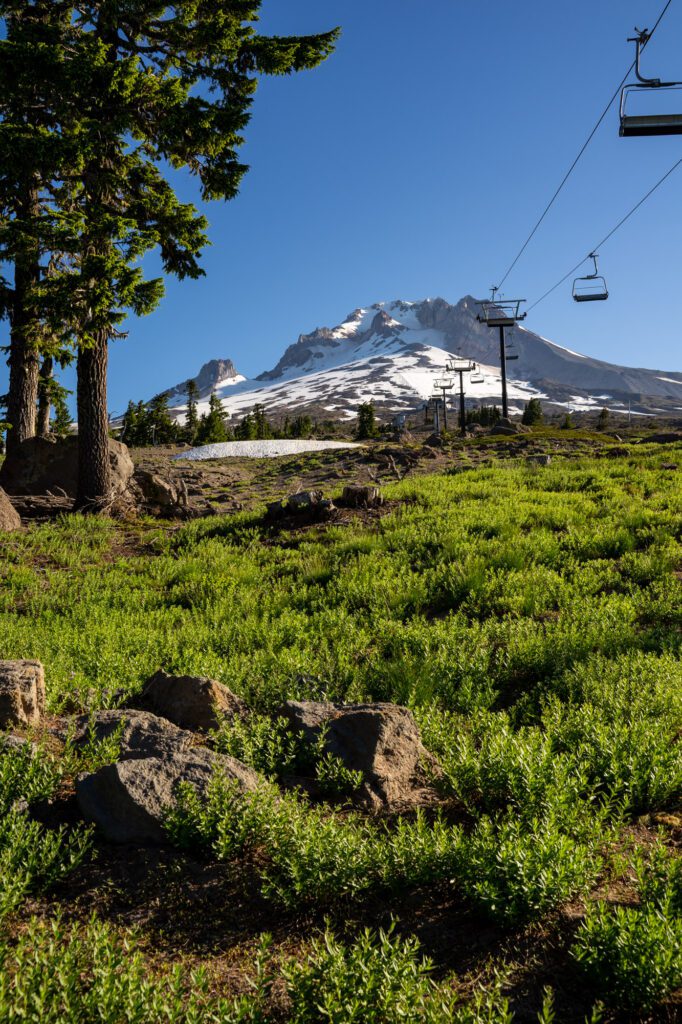

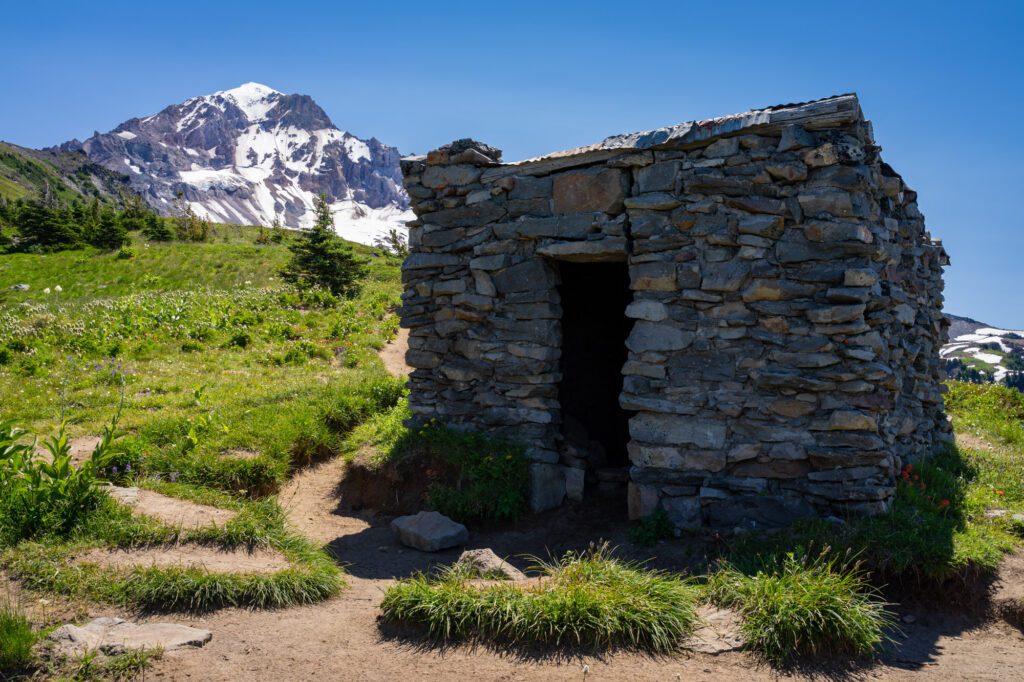
Where to Stay near Mount Hood
The town of Government Camp is the best home base for your explorations of Mount Hood. It’s on the south side of the mountain, and it has the widest selection of places to stay, greatest number of amenities (restaurants, grocery store, etc), and the closest location to most of the trailheads for hikes here.
If you’re up for camping, the Trillium Lake Campground is our pick. We’ve camped there multiple times at this point, and will probably camp there again multiple times in the future. It’s walkable to Trillium Lake, which is one of our favorite photo locations in the state.
If you’re not up for camping, the options are somewhat limited. We’d either stay at the Best Western right in Government Camp, or find a nice cabin in the woods near the town of Rhododendron to use as a home base for a couple of days.
Days 13-14: Portland, Oregon

Drive Time & Distance: 1 hour and 10 minutes // 57 miles
We live in Portland, and we think it’s a fitting end to your epic trip through the Pacific Northwest. In many ways – mostly food and drinks – we’re saving the best for last here.
Portland also offers a nice contrast from Seattle. Portland is much more compact than Seattle, and feels a little bit more down-to-earth with the absence of the tech scene that Seattle has and all the money that brings.
A couple of days in Portland doesn’t really leave you with all that much time, but it’s enough to see some of the highlights (and start putting places on your list for a return trip).
Broadly speaking, we usually recommend spending a day exploring the downtown core (the west side of the Willamette River, which runs north/south through the middle of Portland), and a day east of the river exploring the neighborhoods on the eastside (where we live and think Portland is at its best).
What to Do in Portland
There are far too many things to list for Portland, so we’re going to go with our top recommendations here.
Powell’s City of Books: We bring every visitor to Powell’s, the largest independent bookstore in the world. Specifically, the multi-story downtown location. Matt is incapable of walking out of that store without at least 2-3 new books.
Hit the Markets! The PSU Farmers Market, which is also on Saturday mornings (8:30am – 2pm) down at Portland State University’s Campus, is a must-do. It’s about a 10-15 minute walk from Downtown, and it’s the biggest farmers market I’ve ever been to. The Portland Saturday Market, which focuses more on arts and crafts, is also worth a stop. Both ONLY happen on Saturdays, but are worth prioritizing if you happen to be here on a weekend.
The International Rose Test Garden: Portland is known as the City of Roses (which was essentially created as a marketing slogan for the city after the timber industry took a hit). And this is the most convenient place to see them. 10,000 of them, in fact. They bloom between June and October (ish), and we also come here often during that timeframe to see the roses of all shapes, colors, and sizes. In the fall (call it late September through mid-October), it’s also worth going to the Portland Japanese Garden to see the brilliant fiery hues of orange and red with the Japanese Maples (it’s also just a lovely place to spend an hour – we’re members!).
Eat some Doughnuts (Donuts?): First thing’s first, somehow Portland became famous for its donuts, and the conversation around the “best donuts in Portland” is fairly contentious. We think the best way to decide is to try them all – here are three spots that consistently rise to the top. If you’re really into donuts, then you should probably hop on the Underground Donut Tour, which takes you to five of the best stops for donuts in the city.
Note: These aren’t gluten free (NOT EVEN CLOSE), but if you are looking for some of the best gluten free donuts we’ve ever had, head to Petunia’s Pies and Pastries on the weekends – they’re 100% gluten free AND vegan.
- Voodoo Doughnut is the Insta-famous spot and their location in Downtown Portland has a line around the corner most mornings. Come here for the novelty donuts, like donuts topped with Cap’n Crunch. However, the donuts certainly aren’t the best that Portland has to offer (though it’s a fun experience). We’d also recommend going to the location across the river (here on Google Maps) which is both less busy and a more pleasant location.
- Blue Star Donuts, who are expanding outside of Portland to cities like Los Angeles now, is the pick for the actual best donuts in Portland according to Alysha, her mom, my mom, my brothers, and my friends who came to my bachelor party – but they’re not cheap. They’re “artisanal” so you’ll need to budget $4-5 per donut. They have some fun flavors, like Blueberry Bourbon Basil and Mexican Hot Chocolate, so get a couple of different ones to try and split them with your group. “Get the apple fritter” says Alysha.
- Pip’s Original Doughnuts and Chai not only makes Alysha’s favorite chai in Portland, but also makes fried mini doughnuts that are fried fresh to order. They’re a little further out, but it’s worth the journey. Plan on waiting in line if you come on a weekend, but the warm mini doughnuts will make it all worth it in the end.
Explore the Eastside: East of the Willamette River, you’ll find a much more residential part of the city, which is where we think Portland really shines. There are two broad areas we’d prioritize; Northeast Portland (Alberta and Mississippi, where we used to live) and Southeast Portland (Belmont, Hawthorne, and Division, where we currently live). Refer to our 3 day Portland itinerary for what to do, see, eat, and drink in those areas (and for links to more detailed guides).
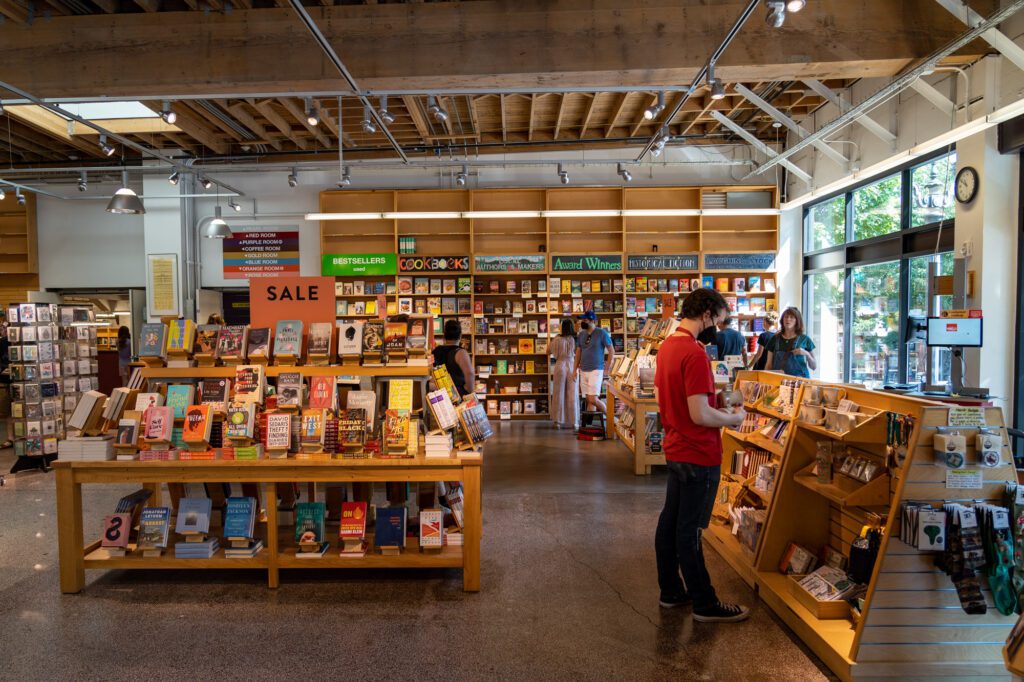

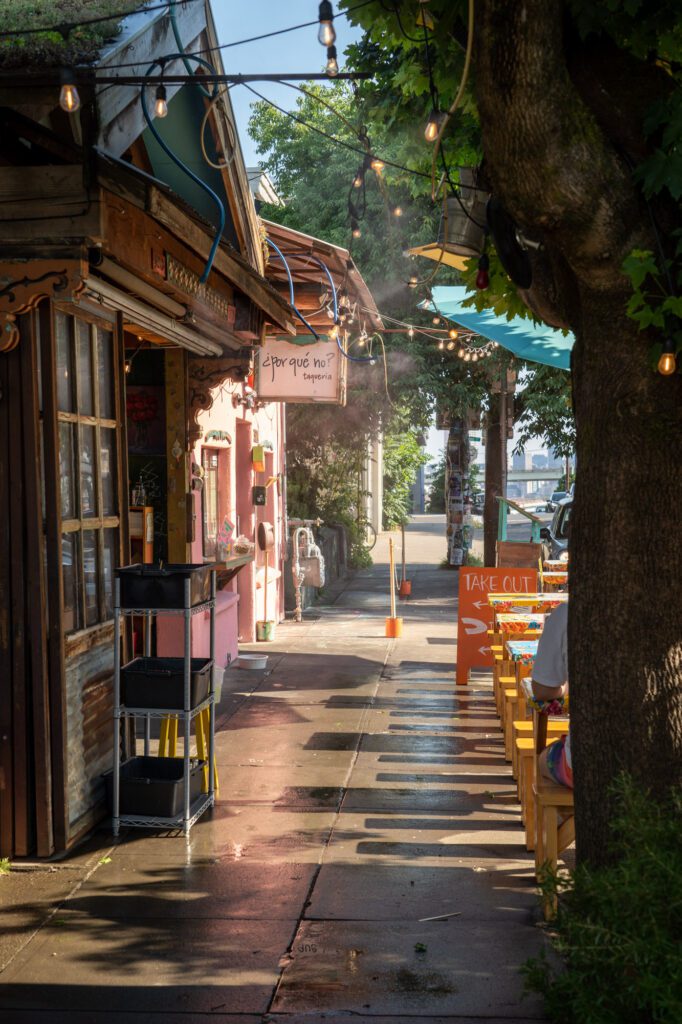
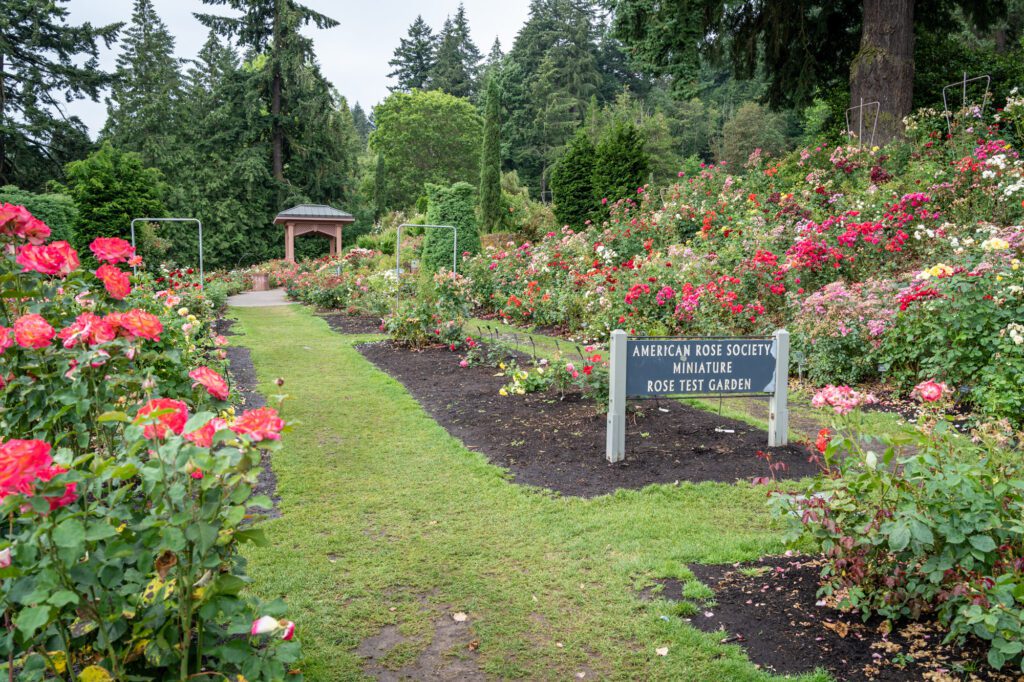
Where to Stay in Portland
We’d stay somewhere central, either in Downtown Portland or the Northwest District.
In Downtown Portland, shoot for somewhere in the southern end near the PSU Campus like the Heathman Hotel or the Paramount Hotel.
We also really like the Hyatt Centric as a slightly more affordable option, which is about as central as it gets.
In the Northwest District, there are only a few options, and the Inn at Northrup Station is the clear winner (we think) in terms of location and value.
For more information (and A LOT more detail), read our guide to the best places to stay in Portland.
What to Do with More Time in the Pacific Northwest
If you happen to have more time for your trip to the Pacific Northwest, here are our recommendations on what to add (in order of our preference).
The Drive from Seattle to Vancouver, B.C. (+7-10 Days)

If you only have a limited amount of time, you’re going to have to choose between the stretch between Portland and Seattle (our recommendation and the focus of the main itinerary above) and the stretch between Seattle and Vancouver B.C.
With an extra 7-10 days, the first thing we’d add is the stretch between Vancouver and Seattle, which is also a magical place. It will require a slight restructuring of your trip (you’d want to fly into Portland, do the main itinerary above backwards to end in Seattle, and then continue north).
Along the way, make stops in Leavenworth, North Cascades National Park, and Bellingham en route to Vancouver.
Because we think the best place to stay for visiting North Cascades National Park is in the eastern foothills of the Cascades, we think you should head east out of Seattle up and over Snoqualmie Pass and over to Leavenworth, which is absolutely worth your time in its own right.
But the real reason we’d include Leavenworth is to access the magical Alpine Lakes Wilderness. This is one of our favorite hiking destinations in the PNW, and though its popularity has exploded over the past decade or so, it’s well worth braving the crowds for the hike to Colchuck Lake.

If you want a slightly less trafficked trail with a similar (though notably less spectacular) payoff, look at the Snow Lake Trail near Snoqualmie Pass (which is on your way over to Leavenworth).
It’s worth noting that if you only have a day or two to add to your Pacific Northwest itinerary, you can absolutely just add 1-2 days in Leavenworth and skip the drive further north.
Once you’re east of the Cascades, you can hug the foothills up to Winthrop, the best home base for North Cascades National Park, before making your way back across the mountains to the charming college town of Bellingham just south of the Canadian border.
From there, it’s a quick drive up to Vancouver.
Here’s a map of what that route might look like.
Note: We had to use bike directions because Google Maps won’t let you change the season on multi-stop routes, which means there are road closures that have it very confused. It’s more like 12-13 hours of driving.
Reminder: Adding this piece to your itinerary means you’ll need to either fly in or out of Vancouver International Airport (YVR) to make the timing work. If you’re renting a car, you may not be able to rent a car in one country and drop it off in another – it varies by agency, and you’ll need to check.
Here are the stops we’d make along the way.
Leavenworth
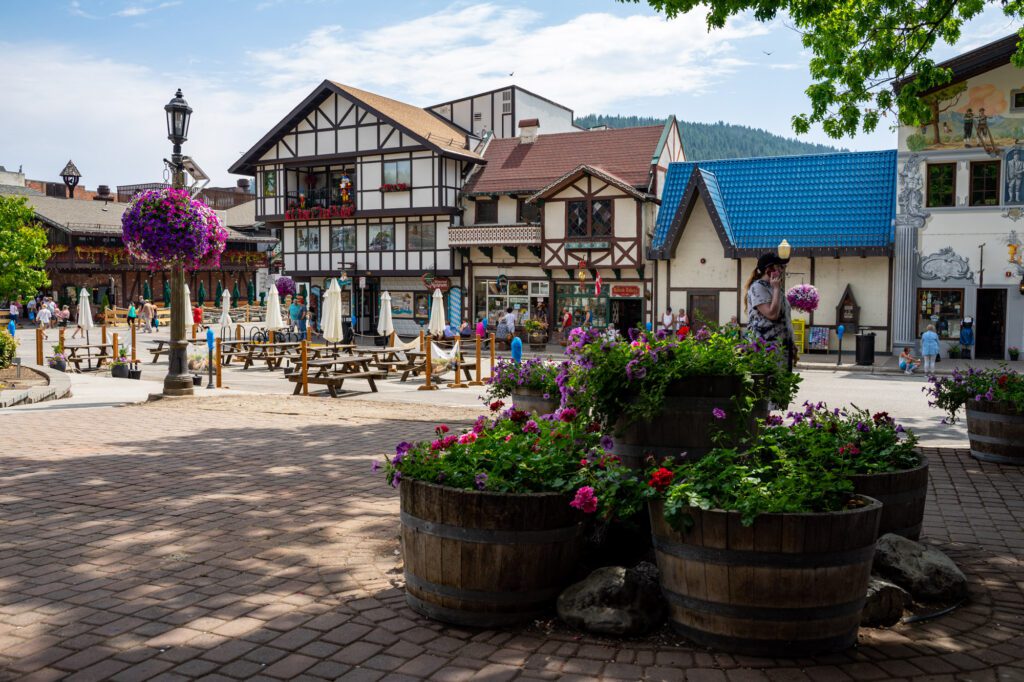
The Alpine Lakes Wilderness has become a sensation over the past few years thanks to the fact that the Enchantments, which is a series of crystal clear lakes backed by rocky peaks, look great on Instagram and TikTok.
While it’s essentially impossible to secure an overnight permit to backpack here, there is one great – albeit very popular – hike that takes you out to one of the many lakes here, Colchuck Lake. And the gateway to this incredible source of natural beauty is the pseudo-Bavarian town of Leavenworth, which sits in the eastern foothills of the Cascades.
If you want to hike to Colchuck Lake, which is only accessible in the summer, we’d suggest spending two days in the area because you’ll need to get to the trailhead no later than 7am (no, we’re not joking) to get a parking spot. Stay in Leavenworth the night before your hike and the night after.
If you’re in town in the winter or spring when the hike is not accessible, or you just aren’t into hiking 9 miles, then we’d recommend a night in Leavenworth (you could even do it as a day trip from Seattle, though it’s a long day).
Read More: What to Do in Leavenworth (for First Timers)
North Cascades National Park

If you want to check off the last of the three national parks in Washington State, you’ll have to journey a few hours north of Seattle to the North Cascades. This is by far the least visited of the three, but that doesn’t make it any less spectacular.
The season here is painfully short (basically late July through the first week of October), but it’s a magical mix of alpine lakes, rocky peaks, and wildflowers/fall color (depending on the season).
It’s home to a couple of our absolute favorite hikes in the world, and we have an entire guide dedicated to hiking in North Cascades National Park that you should read for inspiration.
Bellingham
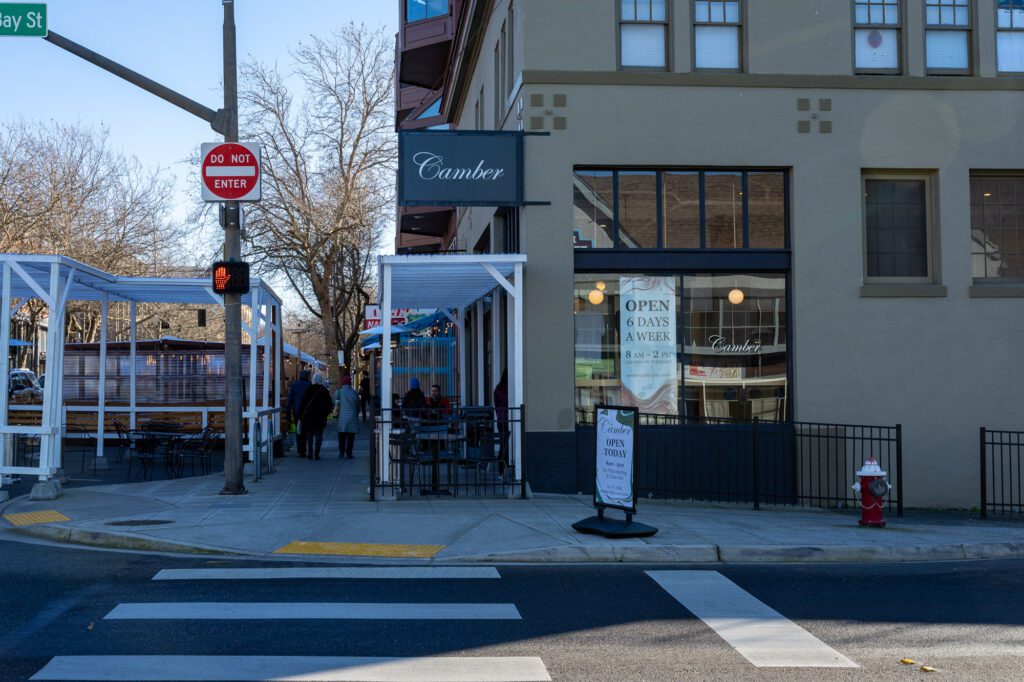
Bellingham makes for a lovely stopover on your way between North Cascades National Park and either Vancouver or Mount Baker (depending on the itinerary you’ve built).
At its core, it’s a college town, but it’s set right on the water with the Cascades as a backdrop, and has a surprisingly good food and drink scene for its size thanks to the fertile farmland that sits right outside of town. That plus a handful of nice green spaces makes it worth a stop.
Mount Baker (only with 10+ Extra days)

Mount Baker is our pick for the most underrated hiking destination in Washington State. If you’re into hiking, this stop is worth your time (it’s probably not worth it if you’re not looking to hit the trail).
It’s another case of being a tragically short season – it’s so far north that it’s basically on the Canadian border, which means August and September are the only reliable months for snow and ice-free trails.
There are a bunch of amazing hikes packed into this relatively small area, and you can read all about them in our guide to the best hikes at Mount Baker. Our absolute favorite of the bunch is Yellow Aster Butte, particularly in late September when the fall color arrives.
Vancouver
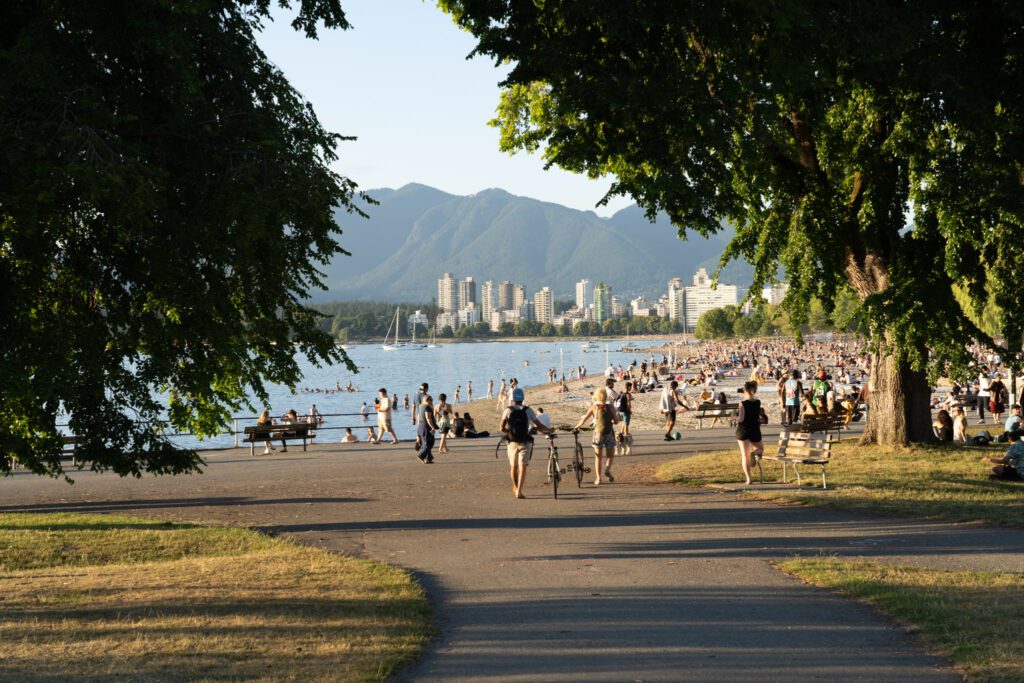
We’ve fallen more in love with Vancouver over the past year or so, which has taken us up to British Columbia’s biggest city twice for a good amount of time on each trip. Before then, we had visited multiple times, but had basically only spent time in the downtown core.
We’re here to tell you that the real magic in Vancouver happens outside of that core in places like Kitsilano and Mount Pleasant, where you have streets lined with independent shops and restaurants.
Vancouver is worth a couple of days (here’s our guide to 2 days in Vancouver!), and more if you want to do some day trips to places nearby.
Putting it all Together
Putting it all together, here’s what that extra 7-10 extra days might look like.
- Day 1: Leavenworth
- Day 2: Leavenworth + Colchuck Lake
- Day 3: North Cascades National Park
- Day 4: North Cascades National Park
- Day 5: Bellingham
- Day 6: Vancouver
- Day 7: Vancouver + Fly Home
If you’d like to add on Mount Baker, here’s what that 10 day addition looks like.
- Day 1: Leavenworth
- Day 2: Leavenworth + Colchuck Lake
- Day 3: North Cascades National Park
- Day 4: North Cascades National Park
- Day 5: Bellingham
- Day 6: Mount Baker
- Day 7: Mount Baker
- Day 8: Vancouver
- Day 9: Vancouver
- Day 10: Vancouver + Fly Home
In both of these scenarios, you’d want to start your trip in Portland, Oregon, and do the main itinerary above in reverse from Portland to Seattle. From there, you could add on the two mini itineraries above to put together a pretty unbeatable introduction to the Pacific Northwest.
Day Trip to Sunrise at Mount Rainier (+1-2 Days)
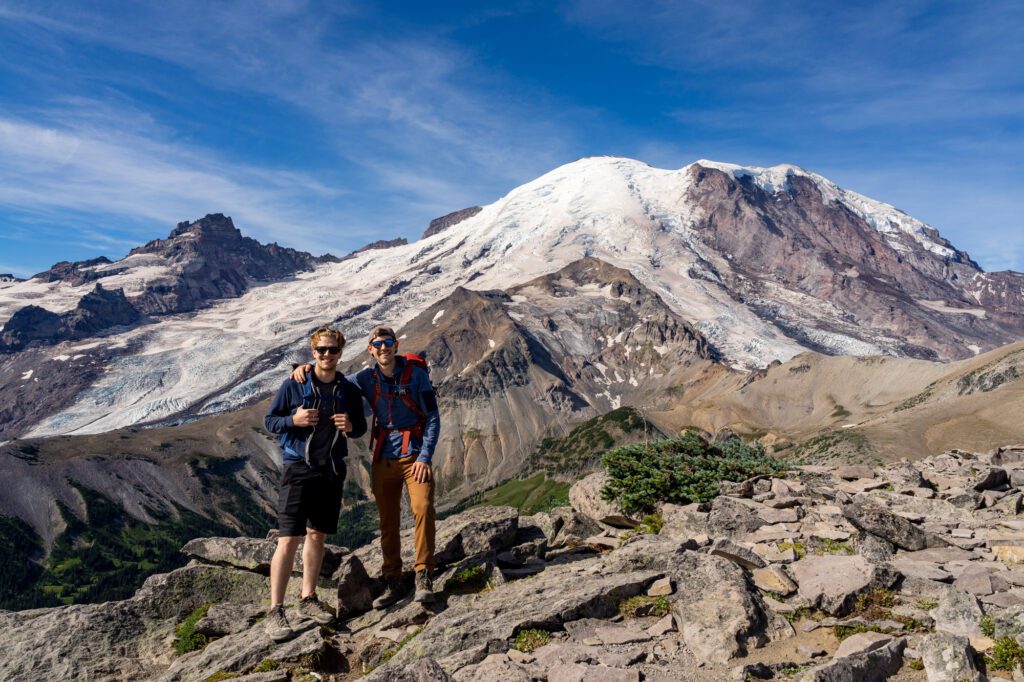
While a couple of days gives you a good amount of time to explore the Paradise side of Rainier – that’s the western flank of the mountain – this 14 day itinerary doesn’t really give you enough time to spend the extra time to get over to Rainier’s eastern side, where you’ll find the Sunrise Visitor Center.
This is the highest point in the park that you can drive to, and an absurd number of our favorite hikes in Mount Rainier National Park leave from this very parking lot. Because of that altitude, it’s also only open in the peak summer and early fall (roughly June to October, but it depends on the year).
Unfortunately, it’s not particularly convenient to go between Paradise and Sunrise, which has been exacerbated by road closures in recent years. And there’s basically nowhere to stay within 30 minutes of the Sunrise Visitor Center (aside from one VERY popular campground).
If you have the time and you’re around in the summer, it’s well worth a trip. It’ll take a while to drive there and back (plan on about 90 minutes each way), but we think it’s probably worth it for the amazing hiking.
A perfect day over here looks like this: start with an early morning (we’d say sunrise) at Tipsoo Lake, then head up to the Sunrise Visitor Center to get an early start on one of the three great hikes here: the Mount Fremont Lookout (a hike to a historic fire lookout on a ridge facing Rainier), Berkeley Park (great wildflowers in the early summer – late July-ish), or Burroughs Mountain (the hardest, but the best way to get into the rocky high alpine territory).
On the way home, consider stopping at Ohanapecosh Visitor Center to walk the shaded path along the river to Silver Falls and Grove of the Patriarchs, an Old Growth Forest (NOTE: The bridge on Grove of the Patriarchs washed out recently, and the trail is closed until construction happens in…2027).
A Detour to Crater Lake National Park (+1-2 Days)
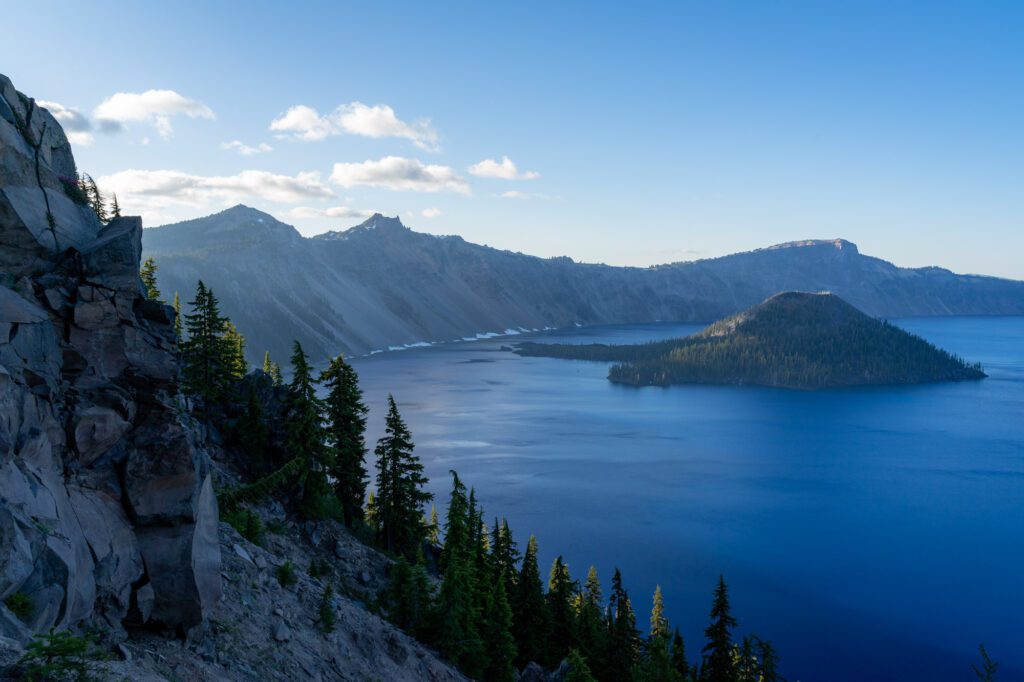
Full disclosure, we have somewhat mixed feelings on including Crater Lake National Park on this itinerary for a few reasons.
First, it’s pretty far out of the way, near Oregon’s southern border. Second, it’s only really accessible for a small slice of the year (you can only circumnavigate the lake from roughly July to October).
Though, as we’ve noted above, that’s the best time to do this road trip anyway (and it’s the only time you can actually get to most places on this list).
However, if you’re already down in Central Oregon in the area around Bend, you’re within striking distance and you should do it as a side trip from Bend.
So if Crater Lake is on your bucket list, that’s probably as close as you’re going to be to Crater Lake without a dedicated trip to it and you might as well make the trip!
There are three things we think you should focus on with your time at Crater Lake.
- Drive the rim road all the way around the lake: This is the best way to see the lake from all angles, and it’ll take you a couple of hours, including stops at the various viewpoints along the way. Start at the Visitor Center on the southern rim, walk a portion of the Discovery Trail from there, and then hop in the car.
- Hike to the highest and lowest points in the park: Mount Scott is the highest point in the park, while Cleetwood Cove is the lowest point in the park, and is the only place where you can get down to the water level. We’d hike both!
- A sunset hike to Garfield Peak: Garfield Peak is right next to the Visitor Center, and makes an excellent place to watch the sunset because you’ll be looking north, where you’ll be able to see the setting sun to the west, and the soft golden light illuminating the eastern rim of the crater.
The other big challenge with Crater Lake is that there’s really not that many places to stay nearby. You’ve basically only got the (very expensive and competitive) lodges and cabins inside the park if you’re not up for camping.
There’s the Crater Lake Lodge, which is the fancy option that sits right on the rim road and has some rooms that have lake views. Then down below the rim there’s the Mazama Village Cabins, which are less convenient but more affordable.
If you’re camping, there’s one campground in the park at Mazama Village. We’ve stayed there, and it’s “meh.”
For more affordable options, you’ll have to head outside the park to Klamath Falls, which is about an hour south of the southern entrance. We have our eye on the lakefront Fairfield Inn and Suites.
The San Juan Islands (+1-3 Days)
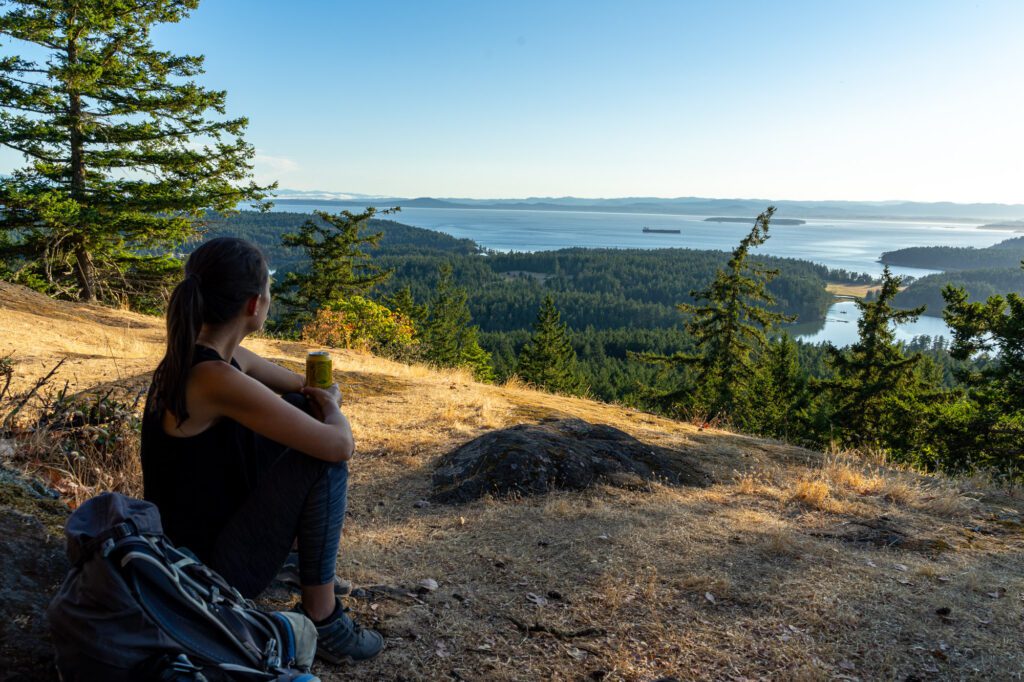
The San Juan Islands are a group of islands off the coast northwest of Seattle, and they are one of our favorite summer getaways from Seattle. Every summer growing up, Matt’s family would pack up the car and go camping out on San Juan Island (which, to be clear, is one island out of the many that make up the “San Juan Islands”).
The geography here is pretty unique, and there aren’t a whole lot of places that we can think of that are similar to these islands.
The weather is slightly cooler and sunnier thanks to the rain-shadow effect of the Olympics (which get ALL of the rain), and it’s a great time to get out on a kayak and explore the islands, which we were lucky to do a few summers ago.
Though, the waters are treacherous thanks to all the currents that meet here, and you’ll need to do a guided trip because it’s too dangerous for 99% of people to do solo.
Plus, the orca whales tend to pass by right off of the western coast of the islands in the summer!
The two main islands are San Juan Island, home to Friday Harbor and the Lime Kiln Lighthouse (where to go to see orcas from shore), and Orcas Island, home to Mount Constitution and some good hiking. There’s also Lopez Island, which is more quiet and low key.
One island can be done in one day / one night, both will take three days / two nights. Obviously, you could easily spend more time (we spent a full week between San Juan Island and Orcas Island last summer).
As you might have guessed, we have guides to the best things to do on San Juan Island, where Matt used to spend a week every summer growing up, and guides to Orcas Island.
What to Do with Less Time in the Pacific Northwest
With less time in the Pacific Northwest, you’re REALLY going to have to focus your time.
With 10 Days
As we mentioned above, with 10 days in the Pacific Northwest, we’d focus your time on the corridor between Seattle and Portland, which would include Olympic National Park and Mount Rainier National Park.
Depending on how much time you want to be spending in the cities themselves (we’d recommend at least one day in each, though two would be better), you could also fit in a day trip or two from Seattle or Portland.
Here’s what that might look like.
- Day 1: Arrive in Seattle
- Day 2: Seattle
- Day 3: Olympic National Park
- Day 4: Olympic National Park
- Day 5: Mount Rainier National Park
- Day 6: Mount Rainier National Park
- Day 7: Hood River + the Columbia River Gorge
- Day 8: Hood River + the Columbia River Gorge
- Day 9: Portland
- Day 10: Portland + Fly Home
With 7 Days
With just 7 days, we’d strongly recommend focusing on the drive from Seattle to Portland, with stops in Olympic National Park and Mount Rainier National Park on the way.
It’s going to be quick, but you’ll get to pack in two national parks and two great cities, hopefully leaving you with the desire to make it back ASAP.
- Day 1: Arrive in Seattle
- Day 2: Seattle
- Day 3: Olympic National Park
- Day 4: Olympic National Park
- Day 5: Mount Rainier National Park
- Day 6: Mount Rainier National Park
- Day 7: Portland + Fly Home
